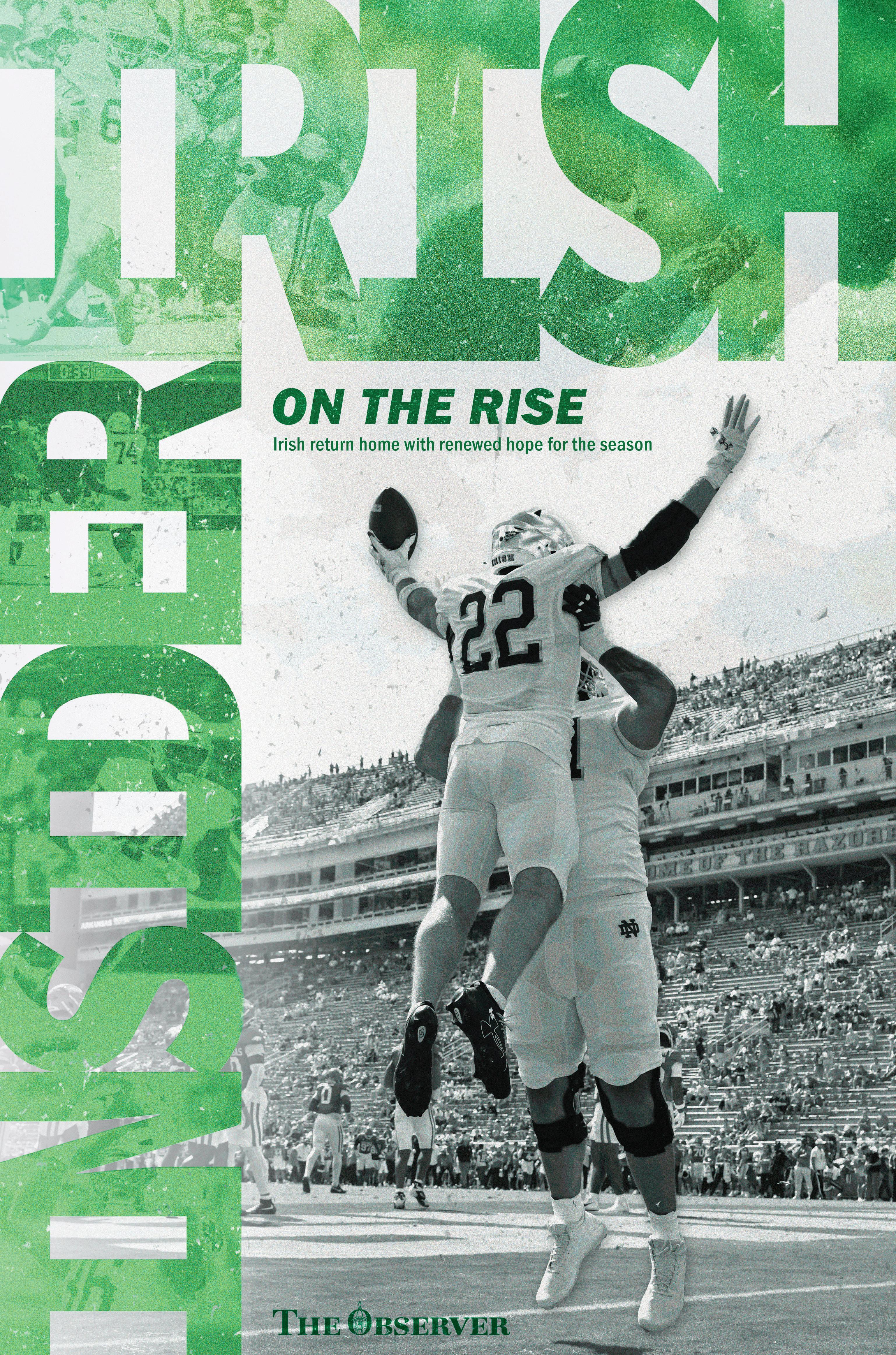

Notre Dame’s keys to victory against Boise State
By Henry Lytle Associate Sports Editor
The Irish emerged from Fayetteville after a 56-13 demolition of Arkansas that resulted in not only hitting the .500 mark on the season against a cruising top-five SEC offense, but also the firing of Arkansas’ head coach Sam Pittman. They follow up the road performance with an opportunity to defend home turf against 3-1 Boise State, last season’s Group of 5 College Football Playoff representative. Here are five ways the Irish can move back to positive in the win column.
Limit big plays
Boise State is averaging 481 yards per game on the offensive side, with nearly 7.8 yards per pass and 4.9 per rush. Until Arkansas, defensive coordinator Chris Ash’s pass defense was suspect to say the least, allowing nearly a first down per pass play. Last week, the defense showed a glimpse of its potential, holding a top-10 offense to a single rushing touchdown and 13 total points, less than half of its season-low 31
points beforehand. The Irish need to continue preventing big passing plays even as preseason All-American defensive back Leonard Moore remains questionable. If the defense can limit chunk plays, it will make an already challenging road contest even more difficult for the Broncos.
Continue to run the ball efficiently
The Broncos have allowed 168 rushing yards per game and 4.5 yards per carry, both of which rank outside of the top-80 in the country. This does not match up particularly well against Notre Dame’s ferocious running back duo of juniors Jeremiyah Love and Jadarian Price, who are both averaging over five yards per carry and at least a touchdown per game. Most recently, the Irish ran for a 200-yard and four-touchdown game against an SEC front in Fayetteville. If the Irish stick with the run early and look to get both backs running in space on the edges, it will be a long afternoon for Boise State.
Avoid turnovers
Boise State has forced five interceptions and three fumbles in their first four games. They will need to get after freshman CJ Carr in the pass rushing department, where they are averaging nearly three sacks a contest, and force the young quarterback to make mistakes. Carr threw an interception in both of the Irish losses, games where the opposing defense logged multiple sacks. Protection will be a key for the Irish offense in this home game where they have steadily improved since the Miami week one contest.
Keep taking shots downfield
CJ Carr has improved throughout every game this season. Following the 350-plus yard, four-touchdown performance, he currently ranks second in total quarterback rating in the country. While this statistical masterclass is unfair to expect from the freshman, it clearly emphasizes just how comfortable and efficient he has been this season with a variety of defenses.
THOMAS H. QUINN SPEAKER SERIES 2025
The Irish executed 13 explosive plays of 20-plus yards against Arkansas, with eight coming from Carr, pushing the defense vertically in the passing game. Carr had several particularly impressive throws to the boundary and is giving his talented receiving core a chance to make big plays, particularly the 6-foot-4 Malachi Fields. Taking deep shots forces the defense to allot more defenders in the secondary and more help over the top, which in turn has allowed the Irish running game to flourish.
Generate pressure
Finally, the Chris Ash defense has a prime opportunity to improve in generating pressure against Boise State. Bronco quarterback Maddux Madsen has only been sacked twice this season and the Irish defense needs to improve in rushing the passer, ranking outside of the top 100 in sack percentage. They earned three drive-crushing sacks against Arkansas, but that number needs to continue to trend in the right direction during this section of the schedule. This
is a great chance for Ash to mix rush looks, experiment with blitzes and utilize different stunts that can maximize the athletic profile of talented rushers at the line of scrimmage. While the defensive line has been solid in defending the run, this game needs to emphasize rushing the passer.
The game will kick off at 3:30 p.m. on Oct. 4 at Notre Dame Stadium. Beginning a threeweek homestand, the Irish hope to improve on a strong Arkansas victory to 3-2 in 2025. get back on track. So just going to work this week and [being] ready for the opportunity, excited for the opportunity.”
Against a Purdue defense that surrendered eight offensive touchdowns to Notre Dame just over a year ago, Fields could be primed for a productive afternoon. Regardless of his output, though, the threat No. 0 has already shown to hurt man defenses downfield or in pockets of zone defense should help the Irish offense remain active.
Contact Henry Lytle at hlytle@nd.edu
CONQUERING THE ULTIMATE DISEASE INSTIGATOR
Reversing the Aging Process
Friday, October 3, 2025
3:30pm - 4:45pm
Jordan Auditorium, Mendoza College of Business Free and open to the public. No tickets or registration required.
ABOUT SERIES
The Thomas H. Quinn Lecture series is an annual event hosted by the Mendoza College of Business and sponsored by Notre Dame alumnus and trustee John W. “Jay” Jordan II, Quinn’s college roommate, longtime friend and business partner, in his memory.

Ronald A. DePinho, M.D. Physician-scientist, serial entrepreneur and past president of MD Anderson Cancer Center
In his talk, Dr. DePinho will share insights into the forces shaping scientific research and its impact on humanity. He will then dive into the mechanisms driving aging and the transformative potential of science to extend healthspan and combat age-related diseases such as cancer and Alzheimer’s. He will provide knowledge on how to live a healthier life.

THE INDEPENDENT NEWSPAPER SERVING NOTRE DAME, SAINT MARY’S AND HOLY CROSS
ND faculty honored with prestigious science awards
By Eileen Doyle News Writer
Four Notre Dame faculty members in the College of Engineering and the College of Science were honored with National Science Foundation (NSF) CAREER Awards — a mark of excellence for earlycareer researchers who integrate teaching, outreach and scholarship into their work. While each of the honored faculty works on very different problems, they all share a belief in curiosity, persistence and bringing both students and teachers into the journey.
Xiaolong Liu, an assistant professor in the Department of Physics and Astronomy, is pushing the frontier of superconductivity research. He is especially interested in non-reciprocal superconductivity, the idea that current might travel more easily in one direction than the other, even in a superconductor,
which usually allows zeroresistance flow. His team is proposing to use a scanning Josephson tunneling microscope, which can probe superconducting current flow at the scale of individual atoms, allowing them to separate intrinsic directional effects from impurities or defects.
“This is an entirely new research direction,” he said. “Detecting directional effects at an atomic resolution has rarely been demonstrated in the past. We have a unique capability to carry out the proposed activities because we have a unique instrument that can do such measurements.”
Liu is also dedicated to education. Through a STEM teachers residency program, he invited middle-school teachers to participate in his lab, co-design curriculum materials and build demonstrations for classrooms or museums.
“We want to get them directly involved in their research so they can have a new perspective on what physicists are doing nowadays,” he said. ”They will codevelop research curriculum materials with us, so they can bring it back to their classrooms.”
To anyone considering a career in physics, Liu’s advice is clear.
“You need to be very selfmotivated,” he said. ”You should become exposed to various topics while you can and find something you are passionate about.”
Marc Osherson, an assistant professor in the same department as Liu, works at the intersection of particle physics and data science. He is part of the Compact Muon Solenoid experiment, one of the two giant detectors at CERN’s Large Hadron Collider in Switzerland
see “Awards” on page 4
ND Energy sees new leadership
By Marie Stier News Writer
Notre Dame Energy, an integration of both Notre Dame’s former Energy Center and Sustainable Energy Initiative, serves as the University’s hub for energy-focused research, education and outreach. As the newly appointed faculty director of ND Energy, chemical and biomolecular engineering professor Joule Bergerson leads the development and promotion of ND Energy’s initiatives on campus.
Bergerson initially became interested in leading ND Energy as she looked for a leadership role that could bring about positive change while fulfilling her passion for research. ND Energy fulfilled these goals for her, and further intrigued her with its mission-driven approach. She hopes to live out the organization’s mission through
community-oriented ND Energy programming.
“[Our focus] is very much to facilitate, to spark, to catalyze new research projects to bring people across campus together, to have a community of people that are interested in energy questions, writ large,” Bergerson said. “I would love to see [ND Energy] be a place that can foster some of those really difficult conversations about where we’re at with our energy system and how we are going to power the next set of demands, both in the local communities as well as writ large.”
One of the difficult questions Bergerson hopes to answer through her work is how Notre Dame as a community can develop its sustainability practices.
“Even beyond climate change is sustainability questions in general. It’s not about
see “Energy” on page 3
McDonald Center launches Peer Listening Program Zombie festival promotes safety
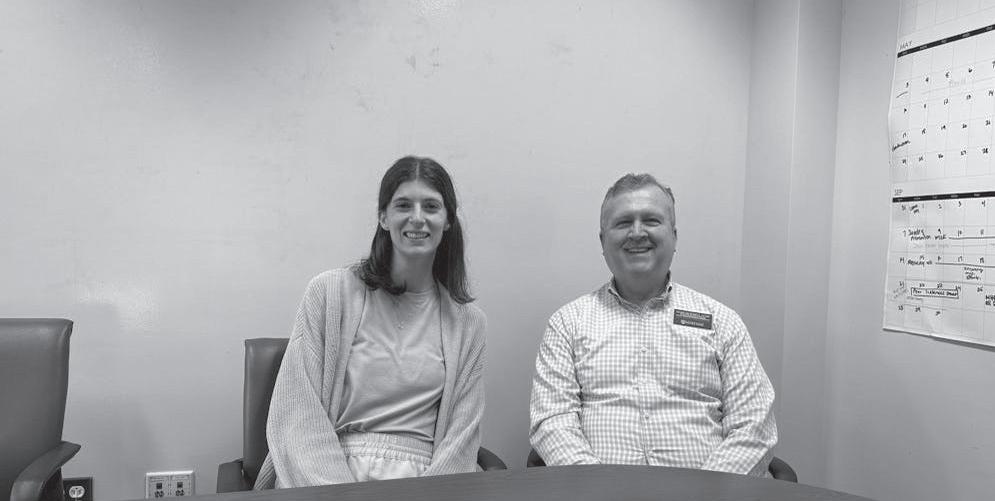
By Camila Figueroa Dávila News Writer
This year, Notre Dame’s McDonald Center for Student
Well-Being launched its pilot Peer Listening Program. The program, funded by a SAMHSA (Substance Abuse and Mental Health Services Administration) grant for three years, aims to provide peer-to-peer
support for students in a confidential and non-judgmental space, offered by trained student listeners. Program directors Camille
see “Listening” on page 4
By Maggie Sheehan News Writer
Outside Notre Dame stadium
Thursday, the Notre Dame Police Department (NDPD) held their annual Zombie Preparedness Festival, which entailed safety demonstrations, prizes, food trucks and staff dressed in zombie
makeup.
At the event, members of the police and fire departments dressed as zombies to spark student interest in their resources and programming. Their faces were covered with gory face paint and fake blood by
see “Zombie” on page 3
Students discern study abroad
By Maria Alice Souza Maia News Writer
Notre Dame Global hosted a series of events this week for students to learn more about the over 30 summer and 50 semester and academic year abroad programs
the University offers as they discern when and if they want to study abroad.
Highlights of the week included a “Myths, Tips, & Tricks” session held in DeBartolo Hall, networking NEWS
OPINION | PAGE 6
Columnist Michael Doyle argues
SCENE | PAGE 7
‘Twitches’ turns 20
As the Halloween season draws near, the Disney Channel original movie has its birthday.
SPORTS | PAGE 8
College football
The elites, surprises, and disappointments after a month of the 2025 football season.
see “Abroad” on page 2
SPORTS | INSIDER 3
Jordan Faison
The junior wide receiver has emerged as a premier option in the dominant Irish offense.
CAMILA FIGUEROA DAVILA | The Observer
aims to provide students with peer-to-peer confidential support.

ndsmcobserver.com
“TO UNCOVER THE TRUTH AND REPORT IT ACCURATELY”
900 Hesburgh Library, Notre Dame, IN 46556
Editor-in-Chief
Liam Kelly
Managing Editor Gray Nocjar
Asst. Managing Editor: Aynslee Dellacca
Asst. Managing Editor: Grace Tadajweski
Asst. Managing Editor: Henry Jagodzinski
Notre Dame News Editor: Sophie Hanawalt
SMC News Editor: Berhan Hagezom
Opinion Editor: Redmond Bernhold
Sports Editor: Noah Cahill
Scene Editor: Peter Mikulski
Photo Editor: Mariella Taddonio
Graphics Editor: Isabelle Rutland
Social Media Editor: Duncan Stangel
Ad Design Manager: Isabelle Rutland
Business Manager: Zack Pohlman
Systems Administrator: Jack MapelLentz
Advertising advertising@ndsmcobserver.com
Editor-in-Chief lkelly8@nd.edu
Managing Editor gnocjar@nd.edu
Assistant Managing Editors adellacca01@saintmarys.edu, gtadajwe@nd.edu, hjagodzi@nd.edu
Business Manager zpohlma2@nd.edu
Notre Dame News Desk shanawal@nd.edu
Saint Mary’s News Desk bhagezom01@saintmarys.edu
Opinion Desk rbernho2@nd.edu
Sports Desk ncahill2@nd.edu
Scene Desk pmikulsk@nd.edu
Photo Desk mtaddonio01@saintmarys.edu
Systems & Web Administrators
webmaster@ndsmcobserver.com
Policies
The Observer is the independent, daily newspaper published in print and online by the students of the University of Notre Dame du Lac, Saint Mary’s College and Holy Cross College. Editorial content, including advertisements, is not governed by policies of the administration of any institution. The Observer reserves the right to refuse advertisements based on content.
The news is reported as accurately and objectively as possible. Unsigned editorials represent the opinion of the majority of the Editor-in-Chief, Managing Editor, Assistant Managing Editors and department editors. Commentaries, letters and columns present the views of the authors and not necessarily those of The Observer.
Opinion space is available to all readers. The free expression of all opinions through letters is encouraged. Letters to the Editor must be signed and must include contact information.
Questions regarding Observer policies should be directed to Editor-in-Chief Liam Kelly.
Post Office Information
The Observer (USPS 599 2-4000) is published Monday through Friday except during exam and vacation periods.
A subscription to The Observer is $130 for one academic year; $75 for one semester. The Observer is published at 900 Hesburgh Library Notre Dame, IN 46556-0779
Periodical postage paid at
NDPD offers comfort K9s for students
By Mara Hall News Writer
The comfort K9 unit of Notre Dame Police Department (NDPD) is made up of Órla, a red fox Lab, and Finn, a golden blonde Lab. Their job entails walking around campus, attending events and responding to calls from students in need.
Órla’s handler is Paul Foley, the outreach, engagement and social media manager for NDPD. Foley shared that Órla spends almost all of her time with him, working alongside him while also living with him.
Finn splits his time between working and living with officers Evan Drinkall and Stephanie Palmer. Both dogs are two years old and were bred and trained by Top Notch Service Dogs in Elkhart, Indiana.
Describing how the dogs’ training was catered to the work they would be doing, Foley said, “They need to be able to not be distracted by
Abroad
Continued from page 1
opportunities for students to meet peers who had previously studied abroad and an information session titled “Funding Study Abroad” held in partnership with the Office of Financial Aid, the Transformational Leaders Program and the Office of Student Enrichment.
Study abroad director Robert Leis discussed the importance of Study Abroad Week for Notre Dame students.
noises, being with the police department, there are sirens and things like that … A lot of their training is making sure they know how to be a good comfort dog, and knowing when someone may need that comfort, because they have that instinct of ‘You look sad,’ or ‘I can tell or sense that you are not feeling well.’”
Foley said that while it’s easy to think of Órla and Finn as Notre Dame campus pets, “Our main goal is actually to answer any calls of distress, maybe some sort of mental distress.”
Explaining the dogs’ role in responding to students in crisis, Drinkall said, “At least in the few anxiety or mental health calls that I have been on with, Finn is almost an outlet for the students … If I have difficult questions to ask or a conversation that needs to happen, but is not exactly a fun one, they are more open to speaking with Finn than they are to me, and it aids them, but also helps us out in our job to make sure that we check all of our boxes.”
expectations of what his team hopes students took away from the week.
Foley estimates that the dogs spend 50% of their time walking around campus, 40% of their time at scheduled events and 10% of their time responding to calls.
Foley said he thinks the University brought on the comfort K9s in an effort to reduce the number of people trying to pet the working Vapor Wake dogs, whose job is to detect explosives.
“Both dogs have been well received, [but] I do not think the campus really knows about them still,” Foley said, noting that each dog can be scheduled by emailing NDPD to visit residence halls, organizations and community members.
Freshman Clara Lawrence reflected upon seeing the dogs around campus. “I think it is good to have more than just the bomb sniffing dogs … I know for my dad, he ran into the bomb sniffing dogs, and he was very sad that he could not say hi to them because he loves dogs, so it might almost be harder for students to see them and not be able to give
them attention. It is good that Órla and Finn are there to take that place,” Lawrence said.
Katie Finn, a senior at Notre Dame, expressed appreciation for the dogs’ presence on campus. “I mean, every time I see them, I stop to pet them, even if I’m in a rush to get somewhere, it’s like, automatically I have time to pet them, and I think I see that in a lot of other students as well,” Finn said.
She shared that during her first two years of college, she struggled being away from her dogs, grieving the loss of a dog and then having to leave a new dog behind when she came back to school. She now books the dogs to come visit her dorm, Pasquerilla East Hall, and enjoys seeing them in the dining hall.
In terms of upcoming events, Órla will be at Puppy Yoga today on South Quad and at the substance free tailgate on Saturday.
Contact Mara Hall at mhall27@nd.edu
Today’s Staff
Photo Mariella Taddonio
Bergstorm
Graphics
Isabelle Rutland
Ben Smith
Opinion
Redmond Burnhold
“[The week] is a really important time for us to be able to get out there and help students understand all the programs that are being offered so that they can get information about academics, information about locations, safety and security and health concerns to make sure that students are prepared,” Leis said.
“Almost 88% of Notre Dame students study abroad as undergraduates. With the last Open Doors Report, we were third in the nation for undergraduate student participation. So, for us, part of it is just making sure that students have all the information or as much information as possible to make a good decision,” Leis said.
He also shared his
“We know that we want them to have greater cultural engagement. We know that we want them to be able to progress towards graduation on time so that they’re getting the academics that they need as well,” Leis said. “I want them to have the opportunity to go abroad and sort of stand in that space ... where they’re outside of their comfort zone, they’re outside of their own culture, they’re outside of that area of familiarity. So, as they navigate those challenges, as they’re confronted with things t hey’re unfamiliar with, they also gain the strength and resiliency to ... know they can do hard things,” Leis said.
He also discussed how Notre Dame global partners from London, Santiago, Hong Kong and Rome came to campus throughout the week to meet with students and share information about new programming and research offerings at their sites.
Leis emphasized that students should understand going into the application process that certain programs such as those in London, Rome, Ireland and Athens receive more applications than space allows for. He said that when they decide which programs they will apply for, with the maximum of two program
applications per student, they shouldn’t select two competitive locations and rather choose a less competitive program that they’re still excited about for their second choice.
“I’m very impressed by the student body, which has such an appetite for this,” Leis said. “I would love, as time goes on, [for] students to start exploring the world outside of maybe some of the more hotspot destinations. I think that we can see great growth when ... students embrace the possibility of discomfort, when they choose locations that are perhaps more unfamiliar or more outside of the areas that they’ve researched or maybe been to on a vacation or that kind of thing. I think this is a good time for students to sort of push themselves a little bit further and experience something different,” Leis said.
Senior Grace Leeson did a semester abroad in Puebla, Mexico for students on the pre-med track. Leeson, who is applying to medical school, discussed her time living with her host family and taking classes in Puebla.
“We only spoke Spanish at home, and then I attended a Mexican university called UPAEP [Universidad Popular Autónoma del Estado de Puebla], and there I took classes that were in Spanish
with ... Mexican students and Mexican professors. So it was a very immersive experience,” Leeson said. “Living with the host family, you really got to learn about the culture through the food. Also, I just love my host mom. She was fantastic and really welcoming. And then I also really loved my experience at school. I was able to make a lot of local friends.”
Leeson shared that her grandmother is Cuban, and because of her heritage, learning Spanish has been a lifelong goal for her. She now hopes to use her Spanish skills as a physician, serving Spanish-speaking patients back home in Texas.
Leticia Cavadas, a sophomore studying mechanical engineering from Brazil, described her experience studying abroad in Berlin last summer.
“I was able to experience history museums, art museums and even industry museums, as well as trying traditional German and Bavarian food,” Cavadas said. “Academically, being in Berlin allowed me to see the many vehicle manufacturers in Germany, such as Volkswagen and BMW, which to me was extremely interesting, and I had the privilege to study European history exactly where it happened.”
Contact Maria Alice Souza Maia at msouzama@nd.edu
Zombie
Continued from page 1
members of the Saint Mary’s Theatre Department.
The Notre Dame and South Bend fire departments, Notre Dame departments of sustainability, cybersecurity and travel safety and the Red Cross Club of Notre Dame made up the organizations tabling at the event.
The Red Cross Club guided students and community members in attendance through CPR practice on dummies in order to teach them proper emergency procedures.
Lisa McCreary of the South Bend Fire Department and her
Energy
Continued from page 1
just looking at the cost of different ways that we could produce electricity in Indiana, it’s also about greenhouse gas impacts and the other factors that could affect a decision. Oftentimes, when we’re making choices about energy, it’s about complicated tradeoffs, rather than one solution that’s going to be the right economic choice and the right environmental choice,” Bergerson said.
colleague Melissa Stephens, the department’s digital communications and multimedia coordinator, spoke about the importance of the event in terms of raising safety awareness.
“This is a great event for students to have all these resources in one location that they might not otherwise know how to find,” McCreary said.
The firefighters shared information about the common causes of fires and how to prevent them. “We’ve seen a lot of kitchen fires recently, but microwaves can be an issue as well,” Stephens said.
McCreary also discussed how the information is
She discussed how ND Energy works in parallel with the Just Transformations to Sustainability Initiative, a University program tasked with responding to sustainability challenges to advance solutions to these problems by generating research projects and events that focus on energy development through the lens of sustainability. Their primary focus is on involving Notre Dame’s student body in tackling these challenges.
“[ND Energy] is very much engaged with the

especially relevant to students, many of whom are learning how to live safely on their own for the first time.
“I would strongly encourage you to be safe in your dorms and apartments and don’t light any candles,” McCreary said.
The Notre Dame police and fire departments offer services for students beyond just firefighting and crime resistance. Their aim is to be a resource for students and to engage frequently with them.
Jake Kalman, a social media outreach engagement intern for the University who works closely with NDPD, helped to coordinate the event. He
undergraduate population and helping to provide student experiences through the Energy Studies minor and lots of outreach activities. We’ll definitely be continuing that, but also seeing where else we could go to have a bigger impact,” Bergerson said.
To determine what ND Energy will focus on, Bergerson aims to go directly to the community.
“[ND Energy] is at a place we can redefine as we see fit. My first six months, at least, will be going out to meet folks on campus to understand
PAID ADVERTISEMENT
emphasized that beyond keeping students safe, NDPD also aims to be a resource for students and frequently engage with them.
“The police department is who keeps us safe. They do more than just respond to fire alarms. Students can reach out for comfort canines, reach out and have someone pick them up for a ride and more. They want to be more engaged on campus,” Kalman said.
One of the features the event sought to promote is SafeBouND, which allows students to call NDPD for a ride at any time.
Austin Poyar, sustainability program manager for operations, spoke at the event
what they liked about activities that had been done in the past, and what they could see as being something that they would be excited to participate in,” Bergerson said.
Establishing ND Energy’s program will take time, but that doesn’t worry Bergerson; she believes the program should be a product of the people it represents.
“I plan to talk to the undergraduates, to graduate students, to faculty members. Stay tuned for opportunities to have some
to encourage students to be more mindful about sustainable practices, saying that the number one thing they can do to increase their sustainability is to know what is recyclable.
Poyar’s table included a diagram depicting “Zombie Apocalypse Rules and Guidelines,” all of which were sustainability-themed. The poster made suggestions to students to improve their sustainability practices by using reusable bags, biking and walking as much as possible, as well as testing drinking water.
Contact Maggie Sheehan at msheeha9@nd.edu
conversations, either oneon-one or in group settings, where I can hear from the community about what they’re interested in. Really, it’s about what this community wants to do and what they have the capability of doing,” Bergerson said. “I am fully confident that there’s a lot of really exciting things to do, but it has to start with the community: from undergraduates, staff, faculty, everybody.”
Contact Marie Stier at mstier@nd.edu
2025 Dean’s Speaker Series Presents: ROBERT ISOM CEO,
American Airlines
The Dean’s Speaker Series is sponsored by the Burns
Listening
Continued from page 1
McDonald, assistant director for student leadership and community engagement at the McDonald Center and Mark Hummell, a behavioral health clinical case manager with the University Counseling Center (UCC), talked about the creation of the pilot program.
Hummell explained that after the University received the SAMHSA grant, administrators at the UCC looked at students’ screenings from University Health Services, along with similar programs at other institutions such as Johns Hopkins University, Duke University and the University of Michigan, to determine what type of program would be a good fit to pilot at Notre Dame. This ultimately led to the creation of the pilot Peer Listening Program for undergraduate students, with a cohort of nine student listeners.
Awards
Continued from page 1
particle accelerator. The CMS detector is the size of a building and records the aftermath of proton collisions that happen nearly at the speed of light. From that data, physicists like Osherson search for signs of new particles or phenomena that lie beyond the standard model of physics.
His project, “Probing Low Mass Final States,” focuses on subtle patterns that might reveal undiscovered physics. Osherson revealed how the complexity of his project can seem daunting.
“The technological challenge that we face is dealing with larger and more complex data sets. The main challenge is that we not only have physics questions, but we must also invent the toolkit to see the answers,” Osherson said.
However, Osherson is not discouraged. In fact, he sees the challenge as the fun part of the job.
“It’s something new every day,” he said.
Outreach is also central to Osherson’s CAREER project. Through QuarkNet, he collaborates with high school teachers to introduce cuttingedge particle physics into their classrooms.
“One of the most rewarding moments is when teachers realize that what we work on, even if it seems advanced, is graspable. It’s not magic,” he said.
To undergraduate students interested in physics or data, Osherson offered encouragement.
“You don’t need to be a genius,” he said. ”What matters is that you’re interested in it and are able to dedicate time.”
Nicholas Ramsey, an assistant professor in the Department of Mathematics, studies smoothly approximatable structures,
McDonald said that the program has three main goals: “listen, validate and refer.”
Elaborating upon these goals, she said, “We really want these student leaders to just be someone that can listen to these students, whether they have any complaints, whether they are upset or excited about something … and then validate their concerns [to] make sure they feel like they’re heard.” She added that peer listeners might refer students to further resources.
She also emphasized the preparedness of the student listeners. She said, “Our peer listeners are really knowledgeable about the various campus resources. We really focused on that in our training.” She specifically mentioned that the peer listeners are aware of the University Counseling Center, University Health Services, Multicultural Student Programs and Services, The Gender Relations Center, and the Center for Student Support and Care.
which are infinite objects built from finite approximations. His work explores the limits of classification in mathematics.
“Mathematicians are in the business of classifying objects,” he said. “In some cases, people tried for years to find order and instead found chaos. In the 20th century, it was discovered that you could actually prove classification is impossible in certain situations.”
His focus is on understanding why classification succeeds sometimes and fails others.
“I’ve spent my career trying to live in that gap between tameness and wildness, and to figure out the contours of that geography,” he said.
Ramsey is using his CAREER support to launch a summer school in logic and model theory for advanced graduate students and to expand outreach to
McDonald made the distinction that the student peer listeners are not counselors or members of the University Counseling Center since they don’t have the corresponding training or education. However, she said, “There’s an advantage to having peer-topeer support, because, you know, sometimes it’s a little harder to talk to someone that’s maybe older than you, or in a different position than you, like a therapist. So we really want to emphasize the peer-to-peer aspect and having that kind of more like horizontal relationship, rather than the authority that might come with a counselor.”
When talking about the application and selection process, Hummell said, “We were so overwhelmed with applications, we actually had to stop them.”
Hummell said they wanted a diverse group of students for their first cohort from different majors, ethnicities, genders and grades, among other categories. He added that they were also
mathematicians and students in regions where access to highlevel logic is limited. When he learned he would receive this award, he said he felt a mixture of contradictory feelings.
“I was relieved, because there have been major cuts to the NSF funding,” he said. ”I also felt a certain amount of survivor’s guilt, as others were also trying to get NSF funding.”
His biggest challenge in his studies has been grappling with the proof of the classification of finite simple groups, a theorem built piecemeal over decades.
“To move forward, I needed to understand the proof, whether it be the proof as a whole or parts of it,” he said. ”Finding the mental capacity to hold it in my head is going to be an interesting challenge.”
To students thinking about a path in mathematics, Ramsey emphasized community and
looking for students who had “an empathetic listening ear.”
The peer listeners are available for drop-in appointments on Mondays, Tuesdays and Wednesdays every week from 7:30 p.m. to 9:30 p.m. in Duncan Student Center room 582.
Both McDonald and Hummell expressed their hopes of growing the program, possibly by increasing the number of student listeners and adding more days to the peer listening schedule.
Sophomore Riley Clavi, a psychology and sociology major on the women’s rowing team, is one of the nine students in the pilot peer listener cohort.
Clavi shared that she applied to become a peer listener after Joshua Diehl, director of undergraduate studies for the psychology department, emailed her about the opportunity.
Discussing the peer listeners’ responsibilities, Clavi said, “I think our number one responsibility is making sure that students are heard. We’re here to
persistence.
“There are no ‘math’ people,” he said. ”There’s a lot of resistance that people feel as they assume math isn’t something they’re suited for because only a special type of person can do it. I think that’s totally wrong. If there’s a myth about mathematics that needs to die, it’s the one that there are math people who are suited for it.”
Fanxin Kong, an assistant professor in the Department of Computer Science and Engineering, focuses on making learning-enabled cyber-physical systems, like autonomous vehicles, drones and robotic arms, both secure and safe. His NSF CAREER project, “Security Foundations of Safe Learning Enabled Cyber-Physical Systems,” examines new vulnerabilities that arise when machine learning is integrated into
listen in a private and nonjudgmental space.”
Clavi described the position as being practice for her future career as a psychologist, but more importantly as a way to be a force for good.
She said, “It’s a part of the Notre Dame mission statement to uphold and be a force for good. I think that this job is a perfect example of that. It’s students helping out other students and saying … we are a Notre Dame family, I have your back. It is just a perk that it’s practice for my future career.”
Additionally, Clavi gave a shout-out to the rest of the peer listener team, saying “I think that we truly have nine of the most kindhearted and supportive individuals. We love each other so much as a team and it just shows. We love our Notre Dame brothers and sisters just as much.”
Contact Camila Figueroa Dávila at cfiguer3@nd.edu
real-world systems and develops defenses to ensure their reliable operation. Kong’s group explores approaches such as safe reinforcement learning, neuro-symbolic AI and realtime recovery methods to guard against attacks and failures. Kong is also dedicated to education outside of Notre Dame. His team introduces students at all levels to robotics and cyber-physical systems through summer programs, annual challenges and undergraduate research opportunities, creating a basis for future innovators in this quickly growing field. Together, these projects highlight the range of research supported by the NSF CAREER program at Notre Dame.
Contact Eileen Doyle at edoyle22@nd.edu


Food Culture Music Costumes Crafts Games Film And More!
PAID ADVERTISEMENT
By Allison Abplanalp Columnist, “Under Further Scrutiny”
If the phrase “once in a blue moon” means rarely, then the phrase “once in a waning moon” should mean never. Ever since I learned about the moon phases in seventh grade science class, I’ve developed a habit of glancing up at the night sky to identify the phase and give myself a gold star for acing Mother Nature’s pop quiz. But over time, that trivia turned into something far stranger. In nine years of casual moon watching, I’ve noticed something deeply concerning: I have never seen a waning moon. Not once. Occasionally, I’ll catch a full or new moon, but between those phases, like Mr. Miyagi’s mantra, it’s all ”wax on, wax off.”
At first, I brushed it off as a coincidence. But after a decade, the odds of this happening feel lower than the odds of finding no Southwest Salad line at North Dining Hall at 12:20 p.m. on a Thursday. In addition to scanning the night sky, I scoured my camera roll, friends’ Instagrams and favorite movie scenes in search of photographic evidence of this elusive waning moon. Instead, all I found was an abundance of waxing moons. There was so much wax I began to think I was living in a beehive!
So why am I speaking up now?
I think society is finally ready to hear this truth. In the 1690s, little girls would have accused me of witchcraft for questioning such societal norms. In the
The waning moon does not exist
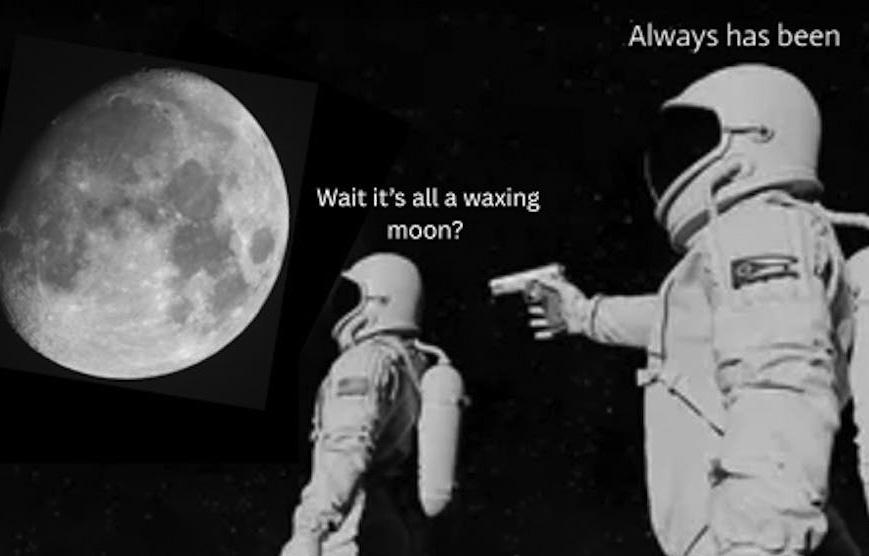
1950s, I would be condemned as a communist for challenging any truths about the moon and thus the moon landing, though to be clear, I would never dispute the accomplishment of astronaut and fellow Ohio native Neil Armstrong. But I’m no witch or communist, merely a courier of the truth.
This semester, I enrolled in an astronomy course, hoping for answers. But when I raise my concerns in class, the professor tells me to “try and take the class seriously,” to which I remind her I am a senior business major fulfilling my Ways of Knowing 3 requirement. Even still, I can tell she’s nervous. Even a trip to the Jordan
Hall observatory revealed nothing but waxing phases. But I’m not giving up. I won’t be phased. Sometimes I think I’m stuck in my own Groundhog Day plot. Bill Murray relived Feb. 2 until he found true love. Am I reliving the same moon phase until I finish some cosmic task and unlock my true timeline? Or maybe all I have to do to break the cycle is start feeding my fish.
Speaking of movies, as I scoured the world’s cinematic history for waning moons, I did find one movie featuring a waning moon: “The Truman Show.” Could the absence of waning moons be a glitch or the stage manager’s oversight? It would
surely be a shock to learn I am living in a manmade skybox. But this would explain why Notre Dame’s premier space club, IrishSat, has yet to launch its satellite. The biggest downside to this explanation is that it would mean the only people laughing at my jokes are paid actors, a crushing blow to my ego. If I am living in a TV show, all I ask is that the scriptwriters please incorporate lots of wealth into the storyline and perhaps a scene where I heroically save a child from a burning building.
Perhaps it’s unrelated, but I’ve also never met anyone named Wayne. I’m worried someone’s trying to silence the Waynes, and
The paradox of quantification
This past week, Oura Health Oy, the company that sells the famous Oura ring, which tracks sleep, menstrual cycles, stress and more, reported raising $875 million in Series E funding, which is the fifth round of fundraising from a startup that has not declared for an initial public offering yet. For a private company, achieving Series E funding is exceptional, and for it to do so at such an exponential rate is even more unprecedented.
Oura’s pioneering rise should encourage us to reflect not only on how the field of health is changing, but also on how our values are. The exacerbating growth of this company reflects the rising trend to quantify everything we do, and our growing (and concerning) addiction to relying on metrics to measure our lives.
Beli logs our food recs, Goodreads counts our books, Oura and Whoop obsess over health metrics, Strava times our runs and calorie trackers record our meals. We’ve gotten really good at quantifying our lives, so good in fact, that some of us (myself included) often make the mistake of thinking tracking is the same as living.
Here’s the thing: Tracking can

become highly addictive because it provides numerical validation for what we deem “progress.” Put simply, tracking tricks us into believing we’re moving forward simply because the numbers keep rising: more steps walked, more books read, more miles logged. There’s an inevitable dopamine hit in seeing the graphs climb upward, a sense of control in the accumulation of data points.
Each metric offers comfort: “Look, you’re improving. Look, you’re doing life right.” But are we?
This trap of measured “progress” convinces us that the steady accumulation of numbers is synonymous with meaning. So much so that we risk starting to believe the graph itself is the point, as though life were a game of infinite levels, each one unlocked by another run, another
the missing moon phase is their cry for help. Lil Wayne’s been real quiet since this article dropped, and I haven’t heard much of Wayne Gretzky since he retired back in 1999. I’m beginning to worry about them. It could also be the opposite: propaganda by Big Wax. The bees could definitely be(e) behind this. They’re probably looking for some buzz ever since the “Bee Movie” meme hype died down, and Jerry Seinfeld tarnished his reputation with “Unfrosted.”
The final, but least plausible explanation for this phenomenon is that I’ve been seeing waning moons all along and don’t actually know how to identify them. I was in seventh grade after all, and admittedly stopped paying attention in science class in fourth grade, when my biologist father told me I shouldn’t pursue a career in science.
I don’t know if I’ll ever see a waning moon again. If I ever can break this cycle, I hope to find plentiful waning moons waiting for me. After all, when it wanes, it pours. From a glorious gibbous to curvy crescent, let there be light (on the left). So, I’m watching the skies tonight. If the waning moon is real, it can’t hide forever.
The views expressed in this column are those of the author and not necessarily those of The Observer.
Contact Allison Abplanalp at aabplana@nd.edu
streak, another completed checklist. Always moving, never stopping. This culture of productivity — though I’m all for getting things done — reveals a darker side. It suggests we might have misplaced our sense of value, trading presence and meaning for the empty comfort of accumulation.
It is easy to get seduced by this tracking culture. This idea of accumulating “progress” seduces us because it offers the illusion of control. But presence asks something harder of us: to stop looking at the dashboard altogether. To notice, to feel, to actually be here. Because the truth is, the dashboard can tell us how much we did, but in the end, only we can remember how it felt. And maybe that’s the point: The best parts of life will never be data.
The views expressed in this column are those of the author and not necessarily those of The Observer. Contact
But what if the moments that make life worth living refuse to fit into charts or streaks at all? The late-night talks with friends, the long walks around the lakes where no one checks the time or the morning debrief after a successful (or not so successful) night out. Even the way your mom’s voice sounds on FaceTime when she tells you she misses you. These things resist measurement. You won’t be able to track them in any given app or gadget (no matter the technological advancements), yet they are the very fabric of a life well lived.
ALLISON ABPLANALP | The Observer
By Ana Prestamo
Columnist, “Mind the Gap”
LIAM FLYNN | The Observer
What has 13 years of Catholic education taught me?
By Michael Doyle Columnist, “Our Thread”
My life has been defined by religion. You won’t see very many rosaries, icons or prayer posters hung up in my room, but you could certainly surmise the extent of the influence of my Catholic education by knowing my upbringing. While the first 9 carefree years of my life were mostly marked by generic reflections in religion class and begrudging Sunday morning ventures to Mass, these experiences built the foundation for what was to come. Of course, being nearly five years removed from 8th grade means I have a sparse recollection of the actual instruction material, but the effect of Catholic teaching is real. My 7th grade religion teacher was my confirmation sponsor, a regular correspondent in high school and delivered the benediction at my Eagle Scout ceremony.
My enrollment at a Jesuit high school in North Philadelphia marked a 4-year journey of faith, service and reflection. In a certainly not unique experience, this is where I began to give real thought to belief and life. While religious introspection can be achieved no matter the school you attend, at a Catholic institution, it’s not seen as an extracurricular or a frivolous pursuit. Reflection and growth are an inherent part of the system. It’s why many elite Catholic high schools choose to not rank their students. It’s why the graduation and college enrollment rates consistently top out at 100% for decades on end. It’s why so many of those enrollments

are at nationally and internationally-ranked universities.
We continuously hear of the “holistic” college admissions process, where evaluators try to examine the entire person. Students at Catholic schools are primed for these application processes because of this focus on overall growth. Your athleticism or academic prowess never actually takes center stage; in fact, nothing does. What sets you apart from everyone else is the fact that any venture you’re engaged in could be the focal point of your life story. Yet at the end of the day, it’s just a part of who you are: an inherent thing unspoken unless it is called out by others.
Lost in the pursuit of solitary
greatness is the value of well-roundedness. This is precisely what I believe is missing in the public and secular private education system. In these competitive environments, where club, team and all manner of leadership positions are precious commodities, students embrace as narrow of an approach as possible, throwing on horse blinders with a single goal in mind. Left in the dust are their relationships, spirituality and personal development.
After the academic excellence, religious instruction and holistic advancement, the most renowned part of Catholic education is its commitment to service. No matter the institution, service hours are a
requirement and a focus, not merely a side project for your college application. Growing and learning within this culture of service is the most beneficial environment an impressionable student can learn in. It should be no surprise then that we see the benefits in the example these students set in university and beyond.
Don’t mistake the identifier of “Catholic” for a school to imply any sort of exclusivity, however. Sure, those who are part of a different faith tradition are still mandated to enroll in religious education courses, but their engagement and contributions are equally as important to the overall development of the school. Whenever we see
Too busy to be Catholic?
Last Thursday night, I walked over to Dillon Hall’s famous milkshake Mass for the first time with a bunch of my friends. We had a great time — the chapel was beautiful, there was a gorgeous violin and choir, and there were so many people in attendance, we had to sit on the floor. I remember thinking, “It’s so convenient that Mass is such a short walk from my dorm and that I have such wonderful friends to go with.” As I stood in the hall after Mass, chatting and sipping my milkshake, it felt easy to be a good Catholic. Flash forward about 12 hours to Friday morning. I had just finished class for the day, and I had a ton of homework to do. Back at the dorm, I unzipped my bag, starting to take out my laptop and notebooks — and immediately remembered I was supposed to go to adoration. At that moment, it would have been so easy to skip it and get to work on my long list of assignments instead ... and just like that, it was suddenly hard to be a
good Catholic. I feel like faith can feel this way for a lot of people: easy one moment and difficult the next. With our busy schedules and constantly being pulled in different directions, it takes a committed effort to make time for cultivating our relationship with God. That being said, it’s important to remember that faith and the activities in our lives don’t have to be mutually exclusive; in fact, if we learn to approach them the right way, the things we do can actually grow our faith in miraculous ways.
This Wednesday, we celebrated the feast day of St. Thérèse of Lisieux, an incredible woman from late 1800s France who provides the perfect example of using the busyness of our lives as a tool to grow in holiness. Despite having relatively little time on Earth (she lived just 24 years) and living a simple life, Thérèse is still considered one of the great Doctors of the Church. She is famous for her “Little Way,” a method of working toward sainthood in which every task in our lives, no matter how mundane,
becomes a way to serve God. Activities like washing the dishes, doing homework and listening to a friend pour out their troubles, for example, are acts that may seem ordinary on the surface but, as Thérèse knew, are actually quite priceless spiritual opportunities. We can consecrate our work to God, offering up our efforts to Him, and in doing so, engage in a powerful form of prayer and sacrifice. With this method, even the most unpleasant tasks become desirable as a way to suffer for the Lord. We can even use these small sacrifices to pray for certain intentions. After all, not all our prayers have to be vocal; as 1 John 3:18 says, “Children, let us love not in word or speech but in deed and truth.” What great spiritual power there is to be found in simple everyday actions. Imagine our great loss if we were to let all the seemingly mundane tasks of our lives slip away without taking the opportunity to serve God in each one.
With that, I advise you against obsessing over routine activities like going to Mass, adoration and the sacraments
sectarian violence or hear degrading language, we can trace those roots to a culture of exclusion. In being shielded from or intentionally ignoring other faiths, we rapidly lose sight of the real value present in said faiths. Without any prior exposure to cultures other than your own, you’ll be left with no understanding of your peers or colleagues. Extrapolate this to a country of nearly 350 million, and all of a sudden, we’re at odds with nearly everyone, in a dangerous negative feedback loop. Certainly, it is too much to expect any one person to have a total awareness of the multitudes of unique traditions and experiences that are present in the world. However, a Catholic education founded on religious tolerance and cultural exposure outlines a path that we can follow.
While it may be disingenuous to say that Catholic education is absolutely necessary for developing well-rounded scholars, there’s no denying that the current blueprint is very effective. A combination of potent instruction and genuine care builds thinkers, creators and visionaries. The bonds you form, the experiences you go through and the tradition of service that you are enmeshed in are all what make Catholic schools unparalleled in the modern age.
The views expressed in this column are those of the author and not necessarily those of The Observer.
Contact Michael Doyle at mdoyle25@nd.edu
as the only ways to practice your faith. While they are certainly good and essential to a life of faith, if we relegate our relationship with God to these devotional encounters alone, we are essentially dividing our lives into times to be Catholic and times to not. We cannot cram our time with God into a one-hour period of Sunday Mass and expect to grow as a Catholic when that spiritual devotion does not trickle into other areas of our lives. Keep the sacraments and keep the Mass, but also make an effort to transform your daily activities into sacred endeavors. Follow the “Little Way” of St. Thérèse, and you will be surprised at how spiritually fruitful your life becomes.
One last thing to note: We are human, and we are flawed creatures. We will inevitably fail. Therefore, I encourage you to take advantage of our intercessors in Heaven: the saints. Like us, they were once living people on this Earth, their lives filled to the brim with struggles, activities and stress. If anyone understands how difficult it can be to practice our faith in this world, it’s
them. The saints constantly inspire us because despite the challenges they faced, they overcame and are now reaping the eternal rewards. Pray to them often — it is good to have friends in heaven to guide you in your quest to holiness. Learn all you can about them and the way they lived, as it will help you understand and apply what it means to be faithful in your everyday life.
The next time you find yourself “too busy” to practice your faith, say a quick prayer to St. Thérèse and ask her to help you remember her “Little Way.” Then, take up your cross and commit to serving God in whatever activity presents itself to you, no matter how arbitrary or unpleasant it seems. In the words of St. Thérèse, “Remember that nothing is small in the eyes of God. Do all that you do with love.”
The views expressed in this column are those of the author and not necessarily those of The Observer.
Contact Noirin Dempsey at ndempsey@nd.edu
BEN SMITH | The Observer
By Noirin Dempsey
Columnist, “Through the Overton Window”
‘In the Mouth of Madness’: 30 years of insanity
By Harry Penne Scene Copyeditor
Do you suffer from bibliophobia, the fear of books? If so, meet your worst nightmare: John Carpenter’s “In the Mouth of Madness,” which will celebrate the 30th anniversary of its United States release this year.
Known mostly to die-hard horror fans, “In the Mouth of Madness” presents a mind-bending story about the fragility of reality and the horrors of the unknown. When an insurance fraud investigator is assigned to a missing horror author case, he soon discovers that the nightmares in the books are not fiction. What’s worse? This author’s next book concerns the end of the world.
The incredibly unique film is possibly Carpenter’s most underrated, and I cannot recommend it enough. Written by Michael De Luca, it stars Sam Neill, Julie Carmen, Jürgen Prochnow and Charlton Heston.
Carpenter is one of the giants in the horror genre, credited with popularizing the slasher genre with his 1978 film, “Halloween.” He has explored nearly every corner of the genre, including ghost stories (“The Fog”), aliens (“They Live”) and even killer cars (“Christine”). “Madness” is the third installment in his self-dubbed “Apocalypse Trilogy,” preceded by “The Thing” and “Prince of Darkness.” While the films are not directly tied together, the three all tackle the end of the world with very bleak endings.
One of the “In the Mouth of Madness’” most entertaining aspects is its self-awareness toward the horror genre. The villainous author Sutter Cane is a pseudo-parody of

novelist Stephen King, with one character remarking, “You can forget about Stephen King, Cane outsells them all!”
The parallels don’t stop there: Cane’s small New England town, Hobb’s End, imitates King’s own Castle Rock (where several of his most famous novels take place). Throughout the whole film, investigator John Trent insists that Cane is merely a pulp horror novelist and that his books are formulaic and predictable, mirroring many critiques of the genre that prevail even today. Furthermore, Cane has a devoted fanbase, much like King does today, exploring the dangers of obsessive fandom.
The film’s core is an homage to the works of H.P. Lovecraft and his tales of cosmic nightmares and gods. Cosmic
horror is the fear not of one specific monster or ghost, but rather the vastness of the universe in which man is insignificant; the unknown is horrifying. The Cane novels in the film reference real works by Lovecraft (The film’s title is a pun on Lovecraft’s “At the Mountains of Madness.”).
Throughout the film, Trent wrestles with a dilemma: Is he real, or is he fictional, created by Cane to bring about the world’s end? The insinuation that the protagonist is fictional and has no real control is an existential nightmare and truly comes into force at the end of the film as he watches his life play out in a movie, laughing as he accepts his reality, or, rather, lack thereof. My absolute favorite line from the film concerns this existential view: “A
reality is just what we tell each other it is. Sane and insane could easily switch places if the insane were to become the majority.”
Trent’s lack of control over reality is gradually revealed by Carpenter as the film progresses. Little directional choices hint at this: For example, in both the asylum and the motel, Trent is in room number nine. In an encounter with Cane, it is revealed that the author’s favorite color is blue. Every time a character is shown in a closeup, they have blue eyes thereafter. The credits, both ending and opening, are blue. It’s hard to make a color scary, but Carpenter managed to do so. This is one of the reasons why I argue “Madness” warrants repeated viewings; the parallels become evident,
and some of the trippy gaps begin to be filled.
One of the standout aspects of “Madness” is its use of practical effects over CGI. One shot in the film features a wall of monsters chasing Trent down an endless tunnel. While these easily could have been digitally inserted later, Carpenter insisted on building puppets for all of the creatures, and the resultant 18-foot wall had to be operated by 25 crew members. The visual effects in the film were designed by Industrial Light & Magic, the company founded by George Lucas and responsible for the effects in the original “Star Wars” trilogy.
Carpenter is a musician as well as a director, famously scoring the majority of his films. Originally done out of budget constraints and necessity, his scoring quickly became a signature aspect of his films. Known for his heavy use of synthesizer and arpeggiator, “In the Mouth of Madness” actually diverges from the usual Carpenter style. Instead, the film features a more rock-oriented sound that is common to the ‘90s. The opening credit music draws inspiration from Metallica’s “Enter Sandman.” Carpenter wanted to use the song for the film, but licensing the song was beyond the budget, so he and co-composer Jim Lang wrote the track that plays in the film today.
If you are in the mood for a strange, existential horror movie this spooky season, look no further than the nightmarish vision of “In the Mouth of Madness.” Now, I ask the question: Would you read Sutter Cane?
Contact Harry Penne at hpenne@nd.edu
‘Twitches’, it’s your 20th birthday!
By Aly Rothfus Scene Writer
The older I get, the less I enjoy Halloween. It could be that trick-ortreating is no more, the pressure of having a stylish and sexy Halloween costume has become too great or the lack of charming Halloween decor. In order to preserve what is left of my love for Halloween, I turn on some nostalgic Halloween-themed Disney Channel Original Movies and television episodes.
This year marks the 20-year anniversary of one of my favorite Disney Channel Halloween movies, “Twitches.” The film stars Tia and Tamera Mowry as twin witches who were separated at birth. The girls find each other on their 21st birthday, which happens to fall on Halloween.
Being an early 2000s classic, the movie starts off with crappy CGI, which honestly amuses me. We are introduced to the magical land of Coventry that is being taken over by “the Darkness.” The newborn twin princesses, Artemis and Apolla, are in danger. Their father’s friends, Karsh and chicken-wing-loving Illeana, take them to safety in the human dimension. It is said that these twins are the only ones who can save Coventry from The Darkness, a dark
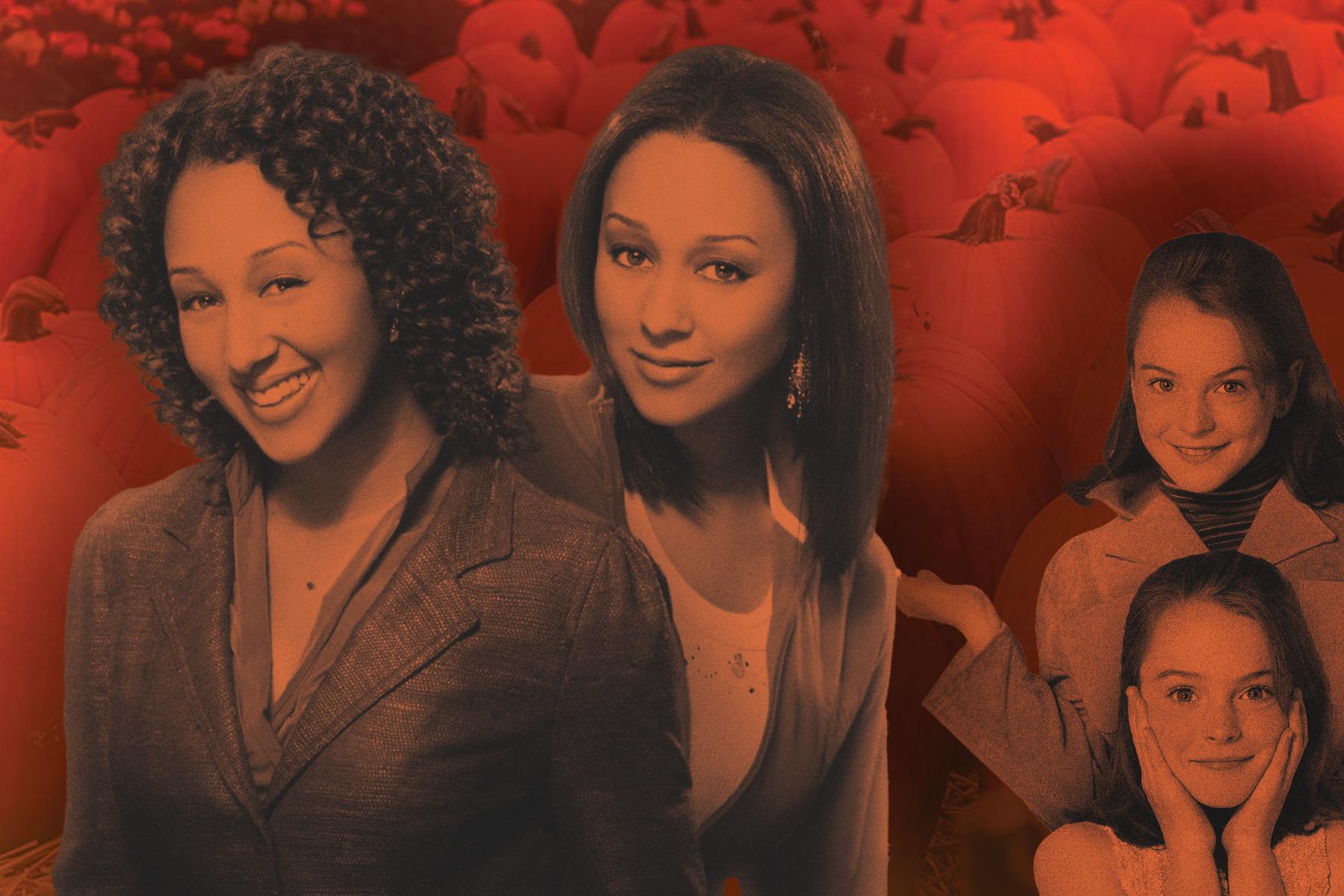
force of nature.
Fast forward years later, and it is the 21st birthday of Alex (Artemis) and Camryn (Apolla). Alex is on a job search, and Camryn is going out clothes shopping. Karsh and Ileana orchestrate a reunion in the clothing store. Unlike Annie and Hallie in “The Parent Trap,” Alex and Camryn catch on to the fact that they are twins quickly. Whenever they hold
hands sparks fly and magical things occur, leading them to the conclusion that they are witches. The more that they uncover about their past, the more they are in danger of The Darkness. Will they be able to protect Coventry and put The Darkness to rest?
This movie never ceases to make me laugh. The characters are charming and goofy. I enjoyed the twins in
ISABELLE RUTLAND | The Observer
a montage of casting harmless spells and watching Illeana and Karsh bicker about the lack of affordability in the human dimension. Karsh would have a heart attack if he saw how much my weekly Cafe J trip costs me. Honestly, I have a heart attack because of the prices myself. Half the time I was giggling at the ridiculousness of the movie — the special effects, the script writing and some
of the acting — but that adds to the charm of the movie. Disney Channel Original Movies are not supposed to be high quality; we watch them for nostalgia and comfort.
Because it is an early 2000s children’s film, I was not expecting to be inspired by the movie. However, as a freshman college student, there was a lot from this movie that I actually resonated with. The twins are young adults: One is trying to find a job, and the other is an art student trying to find purpose in life. Finding each other and realizing that they are witches was not on their 2005 bingo card, but they took it in stride. They embraced each other. Even in times of discouragement, they came out of it ready to do the right thing. The “twitches” reminded me to be open to new things that come out of nowhere, to have fun and to fight for what is right even when it’s difficult. When the Halloween season depression hits, look no further than “Twitches.” Go indulge in some Trader Joe’s gluten-free pumpkin doughnut holes and gather with your friends to watch this classic Disney Channel Original Movie. I guarantee that it will bring your Halloween spirits up.
Contact Aly Rothfus at arothfus@nd.edu
MEG HAMMOND | The Observer
The college football landscape one month in
By Tyler Reidy Associate Sports Editor
Though it’s hard to believe, a month has already come and gone in college football. And with Notre Dame at 2-2, many Irish fans have already started to fervently watch other top-ranking teams and games, eyeing any and all results that can help the blue and gold’s case for a backdoor spot in the College Football Playoff. With October arriving, you yourself may be ready to start scoreboardwatching, so let’s take a look at the national picture after five full weeks of play.
The elites
To the surprise of few, last year’s national champion still holds down the No. 1 ranking. Ohio State, after grinding through a season-opening win against then-No. 1 Texas in Week One, has cruised to a 4-0 start. With their defense allowing a total of 22 points through four games, the Buckeyes haven’t needed much from new quarterback Julian Sayin, but he’s developed a quality rapport with wide receivers Jeremiah Smith and Carnell Tate.
The team Ohio State defeated in the Rose Bowl last season checks in at No. 2. Oregon has perhaps the strongest win in college football now after surviving an overtime trip to Penn State last week. The Ducks’ offense is as well-balanced as it gets with Heisman frontrunner Dante Moore leading the way — more on him later.
Only one more team that
started the year inside the top 10 reached the end of September without a loss: No. 3 Miami. Though they haven’t yet played away from Hard Rock Stadium, the Hurricanes have beaten a trio of quality opponents in Notre Dame, South Florida and Florida. Experienced transfer quarterback Carson Beck hasn’t been anything to write home about, but he’s been steady, which is more than enough to complement the backfield tandem of Mark Fletcher Jr. and CharMar Brown.
Beyond Miami, a handful of high-ranking preseason teams are battling it out with one loss. Penn State, which still hasn’t defeated a power-conference team, didn’t exit the top 10 after losing to Oregon but won’t have a chance to earn a respectable win for at least two weeks. No. 9 Texas, which also hasn’t yet defeated a Power Four squad, opens SEC play at Florida this weekend. No. 10 Alabama appears firmly on the rebound after defeating Georgia in Athens last Saturday, while the Bulldogs, LSU and Florida State all just joined the one-loss club after entering the top 10.
The
surprises
The No. 4, No. 5 and No. 6 teams in the nation all come from the SEC, but they might not be who you’d expect. Ole Miss leads the list after knocking off LSU, as the Rebels look to stick in the national conversation after flirting with it the last few years. Next is Oklahoma,
which already has big home wins against Michigan and Auburn. However, the Sooners will have to operate without starting quarterback John Mateer for the foreseeable future. Texas A&M, which stunned Notre Dame in South Bend three weeks ago, holds down No. 6 and will make the Playoff if it can win at least two of its four secondhalf road games at Arkansas, LSU, Missouri and Texas.
Speaking of the Lone Star State, Texas Tech has climbed from No. 23 to No. 11 and is the current favorite in the Big 12. The Red Raiders have soundly beaten everything on their schedule, including No. 16 Utah in Salt Lake City. A few spots ahead of them is Indiana, which occupies No. 8 after beginning the year ranked 20th. The Hoosiers arrived in the top 10 with a 6310 massacre of No. 9 Illinois two weeks ago, and they’ll be monumentally tested with a trip to Oregon two Saturdays from now.
Vanderbilt’s experienced bunch has also thrown its hat in the ring, landing at No. 16 with a 5-0 start. Quarterback Diego Pavia has played an outstanding brand of football for the Commodores, who demolished No. 15 South Carolina on the road a few weeks back and have scored at least 31 points in every game. They’ll put their unbeaten start on the line this weekend at Alabama.
The disappointments
There’s a pretty easy starting point for this list, and it resides in Death Valley.
FOOTBALL
Preseason No. 4 Clemson’s season has completely derailed already, with the Tigers wearing a 1-3 record and sharing dead last in the ACC with Boston College. The Tigers are 0-2 in conference play, so their odds of rebounding and returning to the Playoff are slim to none.
Turmoil runs deep in the SEC, with preseason No. 13 South Carolina and No. 15 Florida having already departed the rankings. The Gamecocks have lost their way with the ugly loss to Vanderbilt and overall lackluster play from quarterback LaNorris Sellers, while the Gators have matched Clemson with a 1-3 mark and even worse performances from their signal-caller, DJ Lagway.
SMU and Kansas State have faded after respectively opening at No. 16 and No. 17. The Mustangs have already lost twice before starting ACC play, while the Wildcats, like Florida State last season, have spiraled after a seasonopening loss in Ireland.
Heisman watch
As it turns out, winning massive games on the road helps your Heisman Trophy stock. Just ask the two guys currently at the top of the Heisman odds lists.
Dante Moore is the clearcut frontrunner for now after outlasting the Nittany Lions in their house. The sophomore has passed for at least three touchdowns in four of his five games while throwing only one interception to this point. Not far behind him is
Alabama’s Ty Simpson, who just led the Crimson Tide to victory at Georgia. Simpson has played near-perfect football, whether it be in his 17for-17 passing game against Louisiana-Monroe or his season-long touchdown-to-interception line of 11-to-0.
By the end of October, I could very clearly see three or four quarterbacks having their chance to reach the level of Moore and Simpson. Vanderbilt’s Pavia and Indiana’s Fernando Mendoza (16 passing touchdowns to one interception) will each visit a top-10 team before the middle of the month, receiving an opportunity to legitimize their programs before a national audience. The numbers aren’t as sparkling for Beck and Ole Miss’ Trinidad Chambliss, but both lead undefeated teams inside the top five and will face stiff road tests of their own during October.
If you’re wondering, Notre Dame freshman quarterback CJ Carr has begun to appear on the fringes of most top-10 and top-15 Heisman favorite lists. Although with the softness of the remaining Irish schedule, Carr may have already lost his shot at Heisman moments against Miami and Texas A&M. However, if he can keep performing at the level he showed against Arkansas while leading Notre Dame from 0-2 to 10-2, that would become quite the accomplishment of its own.
Contact Tyler Reidy at treidy3@nd.edu
Watson: Notre Dame’s explosive offense
By Claire Watson Associate Sports Editor
The Irish hold high expectations this season. There has not been a game where someone has not asked about or mentioned the College Football Playoff. I felt worried about the season after watching the first two performances against Miami and Texas A&M, but after watching two straight strong bounce-back games from the Irish, I feel stronger about what will happen going forward in the season. The main thing that has contributed to this success is the offense.
As I wrote in a previous article in regard to the offense, “It has performed well, but does not have the same identity as when it was anchored by former quarterback Riley Leonard.”
I take back what I said. Head coach Marcus Freeman said in the weekly press conference, “There was a lot of good in all three phases, improvement from week three to week four for our program.” That quote is extremely true. He also mentioned the new offensive line and defense, saying, “It’s a reflection of younger guys on defense and offense just improving with experience, improving with time. It’s a reflection of the guys understanding what they’re being asked to do.”
Freshman quarterback CJ Carr, who now anchors the new Irish offense, has the ability to step in for Riley Leonard and give this team an identity.
A different one, maybe, but a strong one nonetheless. The Saline, Michigan native has a total of 1,091 passing yards and 272.8 yards gained so
far this season through four games. More notably, he broke records this past weekend against Arkansas with a career-high of 354 yards. He has garnered praise from the national media as well as his teammates.
“I see a lot of greatness in CJ,” junior running back Jeremiyah Love said. “CJ is one of the greatest quarterbacks in college football.”
Two strong players join Carr in the backfield, junior running back duo Love and Jadarian Price. Carr recognizes them as two players who are essential to the team’s success.
“It’s easy when you have Jeremiyah Love and Jadarian Price and the best O-line in the country,” Carr said. “It just takes all the pressure off my shoulders.”
Freeman also commented
on the offense and its promising improvement.
“Our offense is explosive,” Freeman said. “They’re getting big plays. They’re able to control the clock, control the line of scrimmage, and that’s detrimental to a defense.”
Both running backs have risen to the attention of the national media as well, as they have contributed so much to the Irish offense. Love, known for his explosive speed and ability to hurdle over an opposing team’s defender, currently has a total of 341 rushing yards, averaging 5.2 yards per carry. Love has lived in the end zone as well, adding five rushing touchdowns and three receiving touchdowns. Price joins Love with impressive statistics of his own. In 2025, Price has a total of 273 rushing yards, averaging 6.3 yards per carry, to
go with a total of six rushing touchdowns and one receiving touchdown.
Running backs coach
Ja’Juan Seider commented on their incredibly high ceiling.
“The sky’s the limit, we [are] still progressing ... we adapted and I think there’s a lot of room for growth.”
As I mentioned previously, I was wrong about the Notre Dame offense. Should they continue to keep their momentum going, utilizing the two running backs and unlocking the passing game, the Irish should be able to win out this season.
Now 2-2 after the 0-2 start, Notre Dame will look to keep its winning streak alive this Saturday against Boise State, with kickoff set for 3:30 p.m.
Contact Claire Watson at cwatson7@nd.edu
QUESTION OF THE DAY:
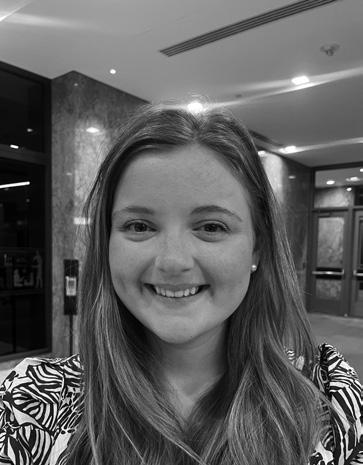
Olivia Seaman
freshman McCandless Hall
“Two stickers.”
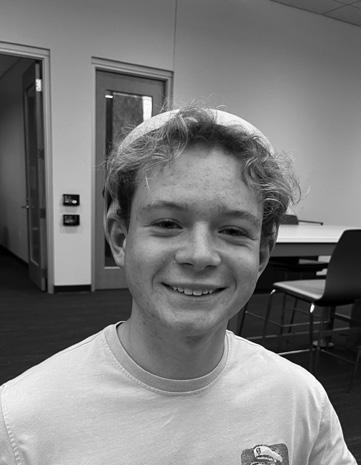
Evan Czuk freshman Legacy Hall
“One sticker.”
How many stickers are on your computer?
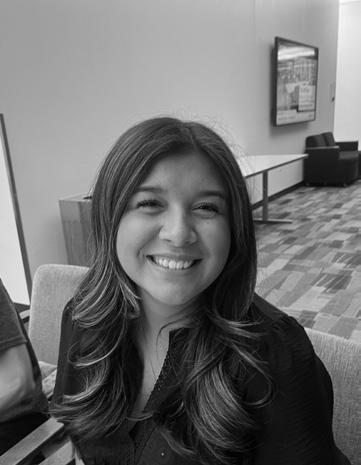
Elysia Morales junior Le Mans Hall
“16 stickers.”
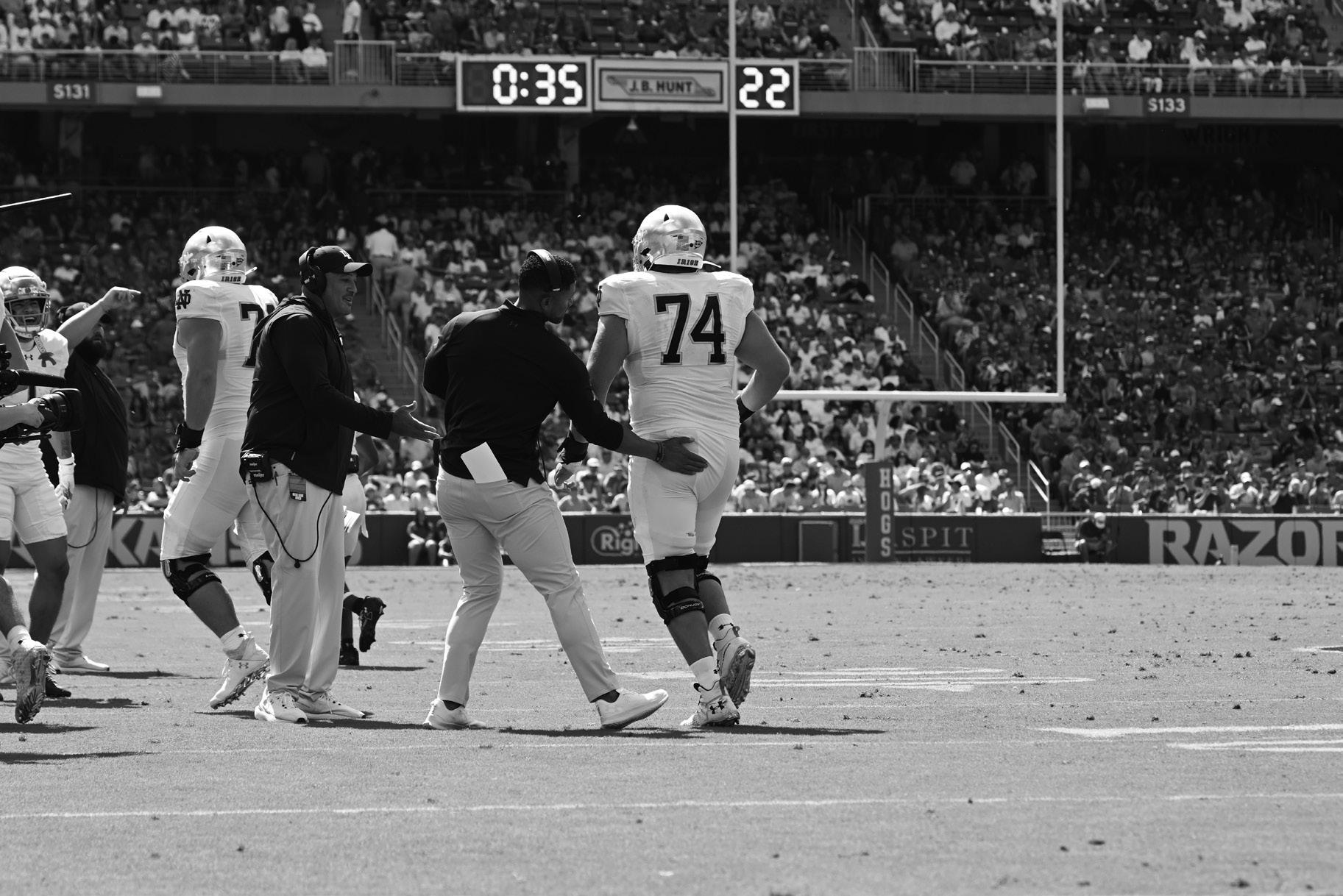
CROSSWORD | WILL SHORTZ
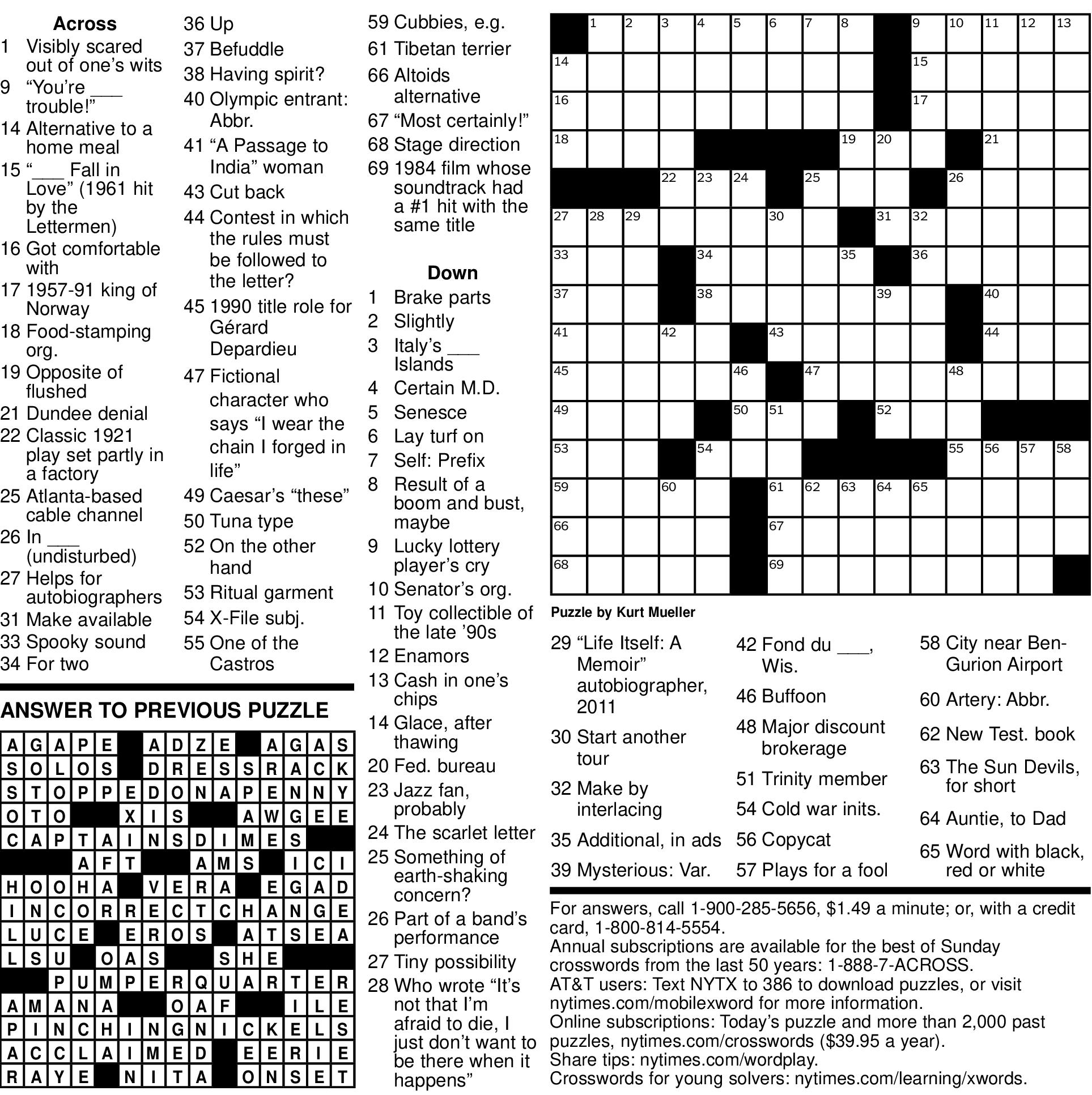
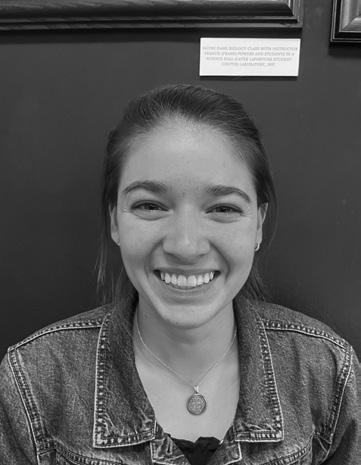
Beth Martinez junior Lyons Hall
“16 stickers.”
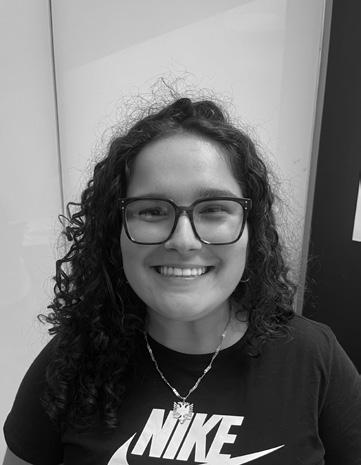
Bora Maloti freshman Pasquerilla West Hall
“Four stickers.”
SOCIAL MEDIA POLL
Have an idea for a poll? Email dstangel@nd.edu
What is your favorite season?
A recent poll conducted by The Observer via Instagram asked students what their favorite season is. There were 157 respondents. A clear majority, 59.2%, said their favorite is fall. Respondents to the survey were equally enthusiastic about summer and spring, with 15.3% of students voting for each category as their favorite season. Winter, perhaps unsurprisingly, lost out, with only 10.2% of students claiming it as their favorite. Students can look forward to pleasant weather this weekend, with highs in the low 80s.
THE NEXT FIVE DAYS
Want your event included here? Email news@ndsmcobserver.com
Friday
Notre Dame Symphony Orchestra Concert
The orchestra will play exerpts from “Romeo and Juliet.” DeBartolo Performing Arts Center 8 p.m. - 9 p.m.
Saturday
Notre Dame football vs. Boise State
The Fighting Irish take on the Broncos.
Notre Dame Stadium 3:30 p.m.
Sunday
Film and Panel Discussion: ‘Nosferatu’ (2024)
American gothic horor film inspired by novel “Dracula.” DeBartolo Performing Arts Center
7 p.m. - 9:15 p.m.
Monday
Red Cross Blood Drive
Blood drive hosted by the Red Cross Club. Duncan Student Center, 8th floor 10 a.m. - 5 p.m.
Tuesday
Notre Dame men’s soccer vs. Green Bay
The Fighting Irish face off against the Phoenixes. Alumni Stadium 7 p.m.
GRAY NOCJAR | The Observer
Head coach Marcus Freeman encourages offensive lineman Billy Schrauth after a play during the Notre Dame vs. Arkansas game on Sept. 27 at Razorback Stadium, where the Irish took home a decisive 53-13 win.
PHOTO OF THE DAY
Men’s golf takes top-5 finish at Windon Memorial
By Harrison Brown Sports Writer
Coming off a win at the Canadian Collegiate Invitational in their last competition, Notre Dame men’s golf made the journey to Knollwood Club in Lake Forest, Illinois. At the course, Northwestern would host the annual Windon Memorial Classic, with a 16-team field competing over two days. The tournament began with 36 holes on day one, which the team left tied for second place on the leaderboards. The second day would not be as fruitful for the Irish as they fell three spots and finished fifth
overall.
Notre Dame kicked off the event by shooting nine under in round one. They followed that up with 11 under in the next round. In the last round, they would finish out the tournament with three over par. Ultimately, the Irish carded an 847, 17 under par.
The top performer for the Irish was junior Jacob Modleski, who was extremely consistent in all rounds of the tournament with scores of 70 in round one, 69 in round two and 70 again in round three. He finished the tournament seven strokes under par and with one of the best individual performances, placing eighth
on the player leaderboards. He was one of three Irish golfers to sink an eagle, with two throughout the tournament.
Following Modleski on the Irish scorecard was senior Nate Stevens, who would shoot three under par and finish tied for 21st. Carding a 70, 71 and 72 in rounds one through three, respectively, he would finish with his best score so far in his senior season.
Senior Calen Sanderson was looking to continue his earlyseason success following a team and individual victory in the Canadian Collegiate Invitational. In round one, the senior shot a 70, and in the following round, he
shot a 68, the best single-round score for an Irish golfer in the event. After the second day, he would add another 78 strokes to his total, finishing even overall and in 38th place.
Rounding out the Irish lineup were juniors Rocco Salvitti and Christopher Bagnall. In round one, Salivitti carded the best score for Notre Dame that round with a 69. He finished the event just one over par and 42nd on the individual leaderboards. For Bagnall, his best round of the tournament was the secon, where he also shot a 69. His final tally of seven over placed him at 70th place.
Illinois would take victory in the Classic and had five golfers finish with a top-15 individual score. 36 under par placed them six strokes in front of second place and 19 strokes in front of Notre Dame. As for the individual standings, New Mexico senior Mesa Falleur captured the title. Falleur shot 12 under par and led his team to a runner-up finish. The next event for Notre Dame will be its very own Fighting Irish Classic. The Irish will welcome teams for the three-round competition on Oct. 6 and 7.
Contact Harrison Brown at hbrown23@saintmarys.edu
Irish head west for key California clashes
By Payton Dymek Sports Writer
Notre Dame volleyball is coming off a tough loss against Syracuse and a sweep against Boston College this past weekend and looks to rebound as they travel to California to play the Stanford Cardinal on Friday night at 10 p.m. and California Golden Bears on Sunday afternoon at 4 p.m. Notre Dame’s sweep of the Eagles displays their control against teams in the bottom of the Atlantic Coast Conference (ACC). However, against higher-ranked opponents, the Irish will need to focus on diversifying their offense and maintaining intensity throughout the match: fighting for every point not just early momentum.
Sophomore outside hitter Morgan Gaerte stayed strong
throughout the weekend with 35 kills, but other players such as sophomore middle hitter Grace Langer and junior outside hitter Sydney Helmers made a huge impact on the box scores, reaching 11 kills and 16 respectively. Although Notre Dame does have strong defensive players such as freshman libero Maya Evens, the Irish need to become more consistent in what balls they pick up in order to turn their competitive losses into wins, especially as ACC competition gets tougher in the coming month.
The Stanford Cardinal will be a tough team for Notre Dame to crack on the offensive, defensive and mental sides. The Cardinal were picked third in the 2025 Preseason ACC coaches poll, coming off a very successful season last year going 28-5
and finishing at the NCAA Regional Final. Stanford currently is 11-2 on the season, with their only two losses coming from Nebraska and Texas, the respective first and second nationally ranked teams.
The Cardinal’s offense and much of their success is reliant on senior outside hitter Elia Rubin. Rubin was named to the 2025 Preseason All-ACC Team, American Volleyball Coaches Association (AVCA) All-America First Team (2024), All-Pac-12 Freshman Team (2023), All-ACC First Team (2024) and even more accolades during her time at The Farm. Aside from Rubin, the Stanford offense boasts players such as freshman middle hitter Erika Sayer and sophomore middle blocker Lizzy Andrew, who have 115 and 113 kills on the season,
which is considerable from the middle position. For perspective, all three of Notre Dame’s middle hitters combined have 88 kills total. Defensively, Stanford is led by freshman libero Spencer Etzler who has 169 digs and Sayer with 50 blocks. The talent pipeline for the Cardinal is as strong as ever evidenced by players such as Morgan Hentz and Kathryn Plummer who hade mave it to Olympic and professional teams, suggesting the standard of Stanford pushes elite players to thrive on the court even beyond college. Last year, when these two faced off in South Bend, Notre Dame fell to Stanford 3-1.
The California Golden Bears will be a competitive team against the Irish as they are currently 5-7, but have faced a challenging schedule
against tough competition this season. The Golden Bears are led offensively by senior outside hitter Peyton DeJardin with 117 kills and senior middle hitter Mikayla Hayden with 115 kills and 57 blocks. California’s defense boasts strengths with players such as junior libero Sophia Johnson, who has 171 digs and is always on her toes, ready for any ball that penetrates the strong Golden Bears’ block. Last year when these two faced off in South Bend, Notre Dame took down California 3-1. After returning from California, conference play will continue for the Irish at home as they face University of Virginia Oct. 10 and Virginia Tech Oct. 12.
Contact Payton Dymek at pdymek01@saintmarys.edu
Men’s soccer continues ACC play vs. Virginia Tech
By Jack Muething Sports Writer
Coming off a 3-2 win against Hope College on Tuesday night, Notre Dame men’s soccer returns to ACC play tonight taking on the Virginia Tech Hokies. The Irish enter the match ranked No. 23 in the country with an overall record of 6-2-2 and a record in conference play of 2-1-0, while the Hokies enter the match unranked with an overall record of 3-2-3 and are still looking for their first win in conference play as they enter tonight’s match 0-2-1. Tonight is the penultimate match in a long seven-game homestand, and the Irish are coming in hot with wins in five of their last six.
The Notre Dame defense
allowed only three goals in their first six matches, but they now have let in six goals in the last two. Led by senior captain Mitch Ferguson, this defense has shown the ability to be one of the best in the nation, but they do have a few questions to answer with their recent performance. Goalkeeper Blake Kelly boasts a 78.6% save percentage to his name and has continued to be one of the top goalkeepers in the nation.
This season started with the defense shouldering most of the workload, but since their game against Pittsburgh, the offense has scored 12 goals in their past five games. Ferguson, largely helped by that hat trick against Wright State, still leads the team
with four goals on the year, but freshman Luke Burton and senior Wyatt Borso trail closely behind, as each of them have three goals on the year. Virginia Tech boasts a very good defense up to this point in the year, but the Irish offense has been rolling in recent games and they will be one of the better units the Hokies have seen up to this point.
The Hokies record of 3-23 may not look too threatening, but they have played a very strong schedule as Notre Dame is the fourth team they will face this season that has been is in the top 25. They dropped their match to Stanford and Ohio, each the 3rd ranked teams in the country at the time but were able to
force a tie against Marshall, who was No. 2 and is currently ranked No. 32 in the country.
The Hokies had been in a bit of a slump though as they were on a five game winless streak, but they were able to get out of it with a 1-0 win against East Tennessee State University Monday night.
Defense has been the key to their game this year, only allowing an average of one goal a game and having four shutouts on the year. The key player to watch for on that side of the ball for the Hokies is Junior Noe Uwimana. He has played every minute of every game for the Hokies so far this year and is the only field player that has done so. They can attribute a large part of their success on the defensive side to him.
Virginia Tech has struggled on the offensive side though as they only average 1.14 goals per game, only scoring more than once in three of their eight games this year. Only one player, sophomore midfielder Alex Perez, has more than one goal on the year for the Hokies. They put up 13 shots per game, which is solid, but have struggled to convert on most of those attempts. They’ll need to get the offense going if they want to win this game as Notre Dame has been one of the best offenses in the ACC recently.
Men’s soccer kicks off at 8:30 p.m. Friday, Oct. 5 at Alumni Stadium.
Contact Jack Muething at jmuethin@nd.edu
Holy Cross women’s soccer falls to St. Francis
By Sam Harshman Sports Writer
On Wednesday night, the Holy Cross women’s soccer team hosted St. Francis as they continue Chicago Collegiate Athletic Conference play. The Saints headed into the match riding back-to-back wins against Judson and St. Ambrose, while also drawing Olivet Nazarene in their previous three conference matches. St. Francis entered the contest 2-1-1 in conference play, including dominant wins over Trinity Christian and Judson, and a loss to St.
Ambrose.
The Saints started the match on a strong note with a goal from junior Frances Parks in the 15th minute, assisted by senior forward Mia Garatoni. This was Parks’ fourth goal of the season, all of which have come in conference play. However, the Saints couldn’t maintain the lead heading into the break as St. Francis’ Mia Ocana leveled the match at one apiece in the 33rd minute.
In the second half, both teams struggled to find the back of the net, aided by Holy Cross’ freshman goalkeeper Janiah Juarez recording
12 saves to keep her squad in the match. In the game’s dying minutes, St. Francis was awarded a penalty. The Fighting Saints seized the opportunity for a road win as Kelly Flores slotted the penalty home to give the Fighting Saints a 2-1 lead, ultimately deciding the match. The Saints finished the game with 16 shots to St. Francis’ 17, highlighting the evenly contested match. The loss marked Holy Cross’ first loss within the CCAC, dropping them to a 2-1-1 record.
The team now turns its attention to Viterbo, another conference foe that they will
face this upcoming Saturday.
The Saints will travel north to La Crosse, Wisconsin to face off against the V-Hawks. Viterbo comes into the match with an overall record of 5-2 and a CCAC record of 4-1. In conference, the V-Hawks have wins over Governors State, Indiana South Bend, Judson, and Trinity Christian, as well as a loss against St. Ambrose in their most recent affair. Viterbo finds itself alone in second place in the conference standings, one spot below St. Xavier. The V-Hawks possess a potent offense, scoring 21 goals in their 7
games, which ranks second in goals scored in the CCAC. This scoring has been done by a pair of freshmen in Brynlee Kelly and Paxten Bristol, who have scored 7 and 6 goals, respectively. This V-Hawk attack will surely provide a test for Juarez and the Saints’ backline.
Holy Cross will look to stay above even in conference play as they enter the final month of the 2025 season, heading up north to face the V-Hawks. The match will kick off Saturday at 1 p.m.
Contact Sam Harshman at sharshma@nd.edu
Belles fall to Kalamazoo in conference opener
Caloe Peretti Sports Writer
Saint Mary’s soccer opened MIAA play on the road Tuesday night with a 2-0 loss to Kalamazoo, the team’s first defeat of the season.
The Hornets scored early in the ninth minute, putting the Belles behind for only the fourth time this year. Saint Mary’s responded with a strong stretch of pressure, forcing Kalamazoo goalkeeper Jess Forbis into saves on attempts from Eleah Hedstrom, Marley Cady and Grace Reyda.
Despite generating chances, the Belles could not find an equalizer. Kalamazoo doubled its lead just before halftime, converting in the 44th minute to go into the break ahead 2-0.
The Belles continued to push in the second half but came up short in front of the goal. Hedstrom led the way with three shots,
including two on target. Isabella Kreydich added two attempts, while Cady, Reyda, Janelle Aiello and Bella Musachio each placed shots on frame. Saint Mary’s finished with nine shots overall and six on goal.
Goalkeeper Meghan Krayer had a busy night in the net, recording a career-high nine saves. Making her third consecutive start, the freshman turned away several dangerous chances in the second half to keep the Belles within striking distance.
On the defensive side, Saint Mary’s relied on its back line to absorb extended stretches of pressure. Brooke Baumann, Danielle Escobedo and Kayla O’Neal all played the full 90 minutes as Kalamazoo pressed for a third goal that never came.
Reyda picked up the team’s lone yellow card in the 62nd minute, and the Belles finished with eight fouls to Kalamazoo’s 10.
The loss was uncharacteristic
for a Saint Mary’s defense that had conceded only three goals through its first eight games. Tuesday’s result marked the first time this season the Belles allowed more than one goal in a match.
Offensively, Saint Mary’s demonstrated they could create opportunities, but struggled to break down a disciplined Kalamazoo back line. The Belles’ six shots on goal matched the Hornets, though Forbis’ saves proved to be the difference.
With the loss, Saint Mary’s falls to 6-1-2 overall and 0-1 in MIAA play. The Belles turn their focus to a three-game home stand that will be pivotal in shaping the next stretch of their conference season.
After nine games and a strong non-conference showing, Saint Mary’s enters October aiming to regroup on its home field and build momentum in league play.
The Belles return to action
Saturday, Oct. 4, when they host Calvin at 1 p.m. They will then welcome Adrian on Saturday, Oct. 11, at 12:30 p.m. for Senior Day, and on Tuesday, Oct. 14,
at 6 p.m. against Olivet in their Morgan’s Message game.
Contact Caloe Peretti at cperett2@nd.edu
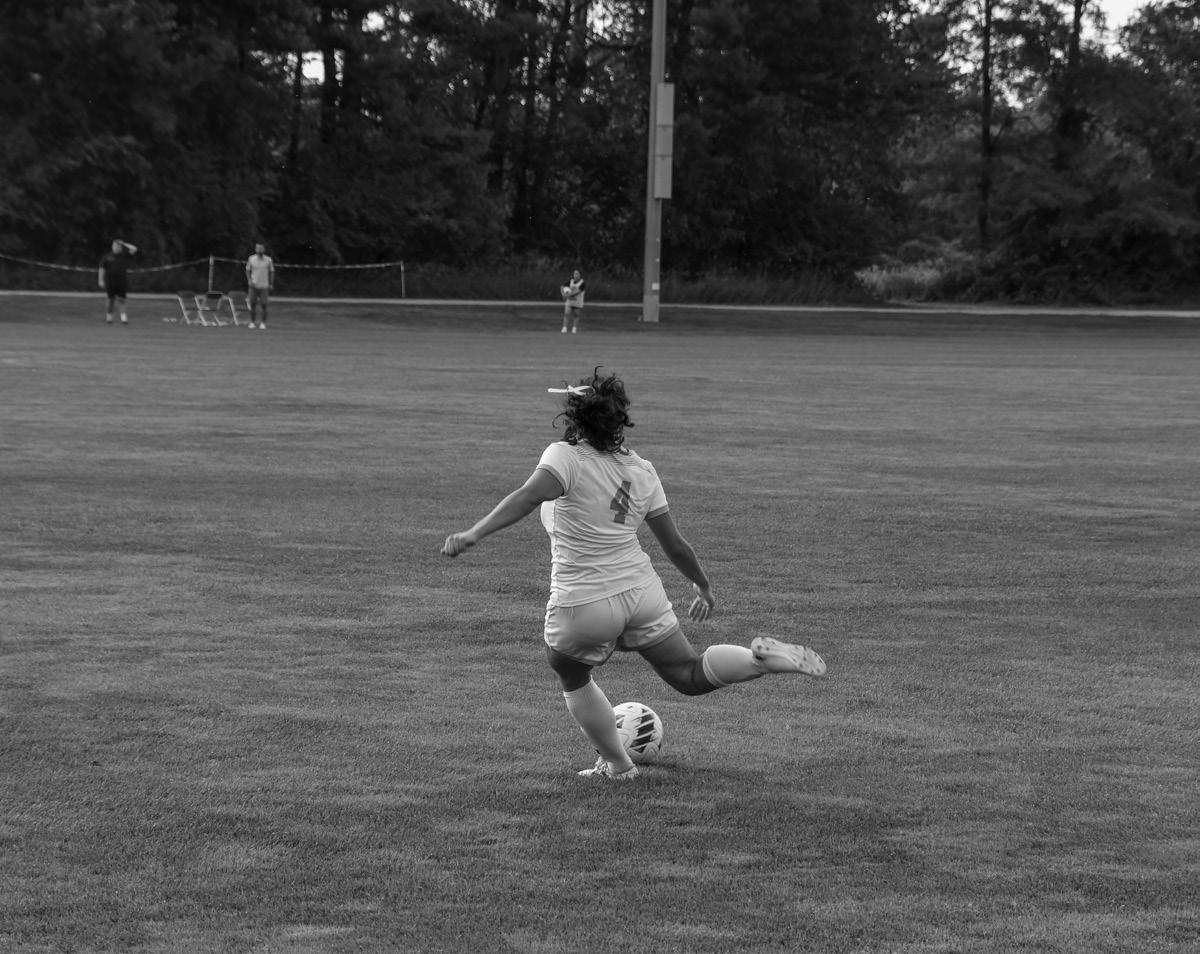
Saint Mary’s volleyball falls to Alma
By Payton Dymek Sports Writer
Alma On Tuesday, Saint Mary’s College was handed their first loss at home against Alma 3-0, falling to 12-3, and 0-1 in the Michigan Intercollegiate Athletic Association. The Scots, meanwhile, improved to 8-9. This game was the Belles’ annual celebration of the Red Glasses Movement, which, as senior middle hitter Grace Braselton described, is about acting on your passions and spreading kindness in your communities. Even after defeating Saint Mary’s, Alma stayed after the game to celebrate with the Belles. Throughout the first set, Alma College had control of the net, tallying an impressive 0.400 hitting percentage with 13 kills and only one error. Meanwhile, junior middle hitter Caroline Carens led the Belles with five kills of her own, hitting 0.571 — more efficient than Alma’s overall team hitting average. Despite the Scots’ control of the net, Saint Mary’s defenders were flying all over the back court, digging the blistering, fast-paced shots seemingly destined for the floor, but also the strategic throws aimed at the corners.
The second set was extremely difficult for the Belles, as Alma swung hard and hit a 0.250 percentage. The Belles attempted to
respond but only managed 10 kills and seven errors, finishing with a 0.077 — one of the least efficient sets of the season. Their lowest mark came from when they hit a 0.100 against North Central in their second loss of the season. In the third set, Saint Mary’s lost confidence and began to falter in their plays. They started to make lots of unforced errors, were more susceptible to being aced and were missing key digs. Toward the very end of the match, Carens and sophomore outside hitter Kalli Lewkowski fought the blockers to get kills that put the Belles back in the game; however, freshman outside hitter
Emily Carling came back with a big swing and won the game for Alma 25-23. Alma controlled the stat sheet, finishing with 40 kills to Saint Mary’s 34, along with a 38 to 34 edge in assists. The Scots also out-dug the Belles 47 to 37 and outscored them 48 to 43. Saint Mary’s was able to dominate the serving line, recording six aces while Alma only had five.
Hope
The Flying Dutchmen are currently 12-4 on the season and riding the high of an eight-game win streak. Hope College is led by three big hitters, all with over 140 kills on the season so far, a statistic that Carens boasts for
the Belles with 179. Senior setter Lauren Lee controls the offense with 574 assists on the season, the highest number from any team facing off against the Belles. Defensively, junior defensive specialist Kathryn Oates leads with 268 digs, anchoring a back row that has been pivotal in Hope’s success on the season.
Saint Mary’s will host Hope College for their annual Dig Pink game on Friday, Oct. 3 at 7 p.m. The Belles will then go on the road for three matches at Trine University, Calvin University and Elmhurst University.
Contact Payton Dymek at pdymek01@saintmarys.edu
SMC VOLLEYBALL
MARIELLA TADDONIO | The Observer
Senior midfielder Grace Reyda tees up the long ball in the Belles’ 0-0 tie against Wheaton (Ill.) at Purcell Athletic Fields on Sept. 19, 2025.
Zackery uses determination to bolster secondary
By Ben Hicks Associate Sports Editor
Under former defensive coordinator Al Golden’s high-pressure defensive system, Notre Dame’s defensive backs wreaked havoc on opposing passing attacks all throughout 2024. With a secondary that included NFL draft selections Benjamin Morrison and Xavier Watts, as well as talented young players in Christian Gray, Leonard Moore, and Adon Shuler, the Irish back half anchored a “bend, don’t break” defense that led Notre Dame to the national championship game.
Entering 2025 with a new coordinator (Chris Ash), and a softer, zone-based system, Notre Dame’s talented secondary was expected to retain their spot among college football’s elite position groups. However, the group was exposed during the opening two defeats to Miami and Texas A&M. There appeared to be confusion and miscommunication, and more uncharacteristically, missed tackles and blown coverages.
Throughout the first three weeks, Notre Dame had allowed 98 points, the second most in school history, and was also staring down injuries to several key players. Moore, a sophomore corner from Texas, has been sidelined since the middle of the A&M contest with a right ankle injury, and Alabama transfer cornerback Devonta Smith has also been nursing a right ankle injury since before that 41-40 loss. Additionally, sophomore safety Adon Shuler missed the end of week two and the first half of week three due to a phantom targeting call.
To fill these voids, defensive backs coach Mike Mickens initially turned to sophomore Karson Hobbs and freshman Dallas Golden. The young cornerback who best proved his worth was neither of these two, however. It was instead the most unexpected of characters. Standing at a scrawny 5-foot-11, 175 pounds, freshman Mark Zackery IV impressed the coaching staff with his preparation and ability to learn on the fly. The in-state athlete from Indianapolis was a highly touted four-star prospect, but didn’t expect to be thrust into action immediately behind such a talented core of corners.
“It’s been a journey, coming in this summer and competing for a spot and then knowing I’d be going in the first game if anyone went down,” Zackery said. He made his debut down in South Beach, before recording his first solo tackle at home against the Aggies. A week later against Purdue, he was already in the starting lineup, recording both a tackle for loss and a pass breakup in the dominating win. “The realization that I was going in, it
was time to buckle my seatbelt and grow up a little bit. So that’s been my process these first four weeks,” he said.
Both the coaching staff and Zackery had confidence he would be ready if his number were called, citing his maturation and preparation. Zackery noted that he has been, “preparing like a starter, whether it’s schoolwork or film. I’m meeting with Coach Mickens daily to make sure I’m prepared like a starter when my opportunity presents itself.”
Head coach Marcus Freeman agreed, saying, “He’s been really intentional about the work in practice and understanding that you have to treat the speed of practice like a game.”
Zackery was also
complimentary of the veterans in the position group, noting how they have assisted him in learning the system. “I’m just gradually getting better and trusting in Christian and Leonard to keep coaching me up at the position so I’m ready to be out there,” he said. Zackery continued to note the learning curve between playing as a man safety in high school to picking up Ash’s system, adding, “I’ve improved drastically, with my body as well, but especially mentally. Coming from a high school where we just played man, and I was playing safety, so just knowing what I’m doing in a situation in the back half is different.”
It’s no secret that Notre Dame’s defense has been dissected and disregarded by fans and media
alike so far this season. The unit was dominant against a top-five national unit in Arkansas last week, holding the Razorbacks to just over 200 air yards and only one offensive touchdown.
The Irish will have another test this week, with 2024 College Football Playoff participant Boise State and their potent offense rambling into South Bend.
The Broncos have averaged 49 points across their prior three games, potentially presenting a crucial test as to whether Notre Dame’s defense has righted its early season wrongs.
With the health of the secondary still in question, and a Bronco offense that likes to air it out in the absence of former Heisman Trophy runnerup Ashton Jeanty, Zackery will
have to continue his growth and solidify a budding Notre Dame backline. Freeman is confident in the youngster’s ability and character. “He wants to be coached. He wants to improve. We knew he had talent, but sometimes during failure you learn if a guy is a competitive individual that wants to take ownership and say, ‘How do I make this better?’” he said.
Perhaps the most glowing review the head coach could provide was his briefest, but it displayed exactly how he feels about the potential of Zackery.
“Whether Leonard’s healthy or not, we have confidence that Mark can help.”

By Chris Dailey Associate Sports Writer
Through Notre Dame’s first two games of the season, junior wide receiver Jordan Faison registered a combined 50 yards receiving. In the past two games, Faison has exploded for a combined 194 yards. His standout performances have helped steer their season back on track, and he isn’t planning to slow down anytime soon.
“I describe him in the quarterback room he’s got like a lucky clover in his back pocket every time because he’s always in the right place. He’s always doing what he should do. Then, when you get the ball in his hands, the body control to make a guy miss, he’s always falling forward. It’s just Mr. consistent,” CJ Carr said of Faison after the Arkansas game.
Just a season ago, Faison was certainly consistent. However, his consistency looked different in the first round of the College Football Playoffs: Faison caught for a season-high 89 yards against Indiana. He stacked up three 25yard games throughout the season and two 46-yard performances as well.
Now taking on a bigger role in offensive coordinator Mike Denbrock’s offense, Faison’s consistency has reached new heights. He’s no longer a supplementary target, but rather the go-to man in
The Lucky Clover: Jordan Faison
an offense that has strung together 24, 40, and 56 points twice to start the year. Faison has been Notre Dame’s leading receiver in both of their two wins and leads the team with 19 receptions. Faison was also the team’s second-leading passer against Arkansas. He earned that mark on a successful fake punt trick play for 40 yards called by Freeman to open up the second half.
“Yeah, it feels great,” Faison said of his development at Notre Dame’s weekly press conference.
“Obviously been putting in work during the season and before the season. Kind of just going through the little things, going through the playbook and whatnot. All of our hard work we’ve put in being able to show is a good thing.”
Faison’s consistent play isn’t just evident in the passing game.
The “lucky clover,” as Carr dubbed him, has also helped open up running lanes for the Irish’s star backfield tandem of Jeremiyah Love and Jadarian Price through tenacious blocking. Although 5-foot-10 and one of the smaller guys on the team, Faison is not shy to make his presence felt.
“Coach has a little competition with us. Whoever can get more might get a little dinner or something at the end of the season, but yeah, everyone has the mentality of going in there and trying to knock you down on your butt. I think
that helps our offensive line and our run game develop and hit big plays,” Faison shared about helping in the blocking department.
Faison’s willingness to assist wherever needed, whether it’s in the run game, special teams or in his traditional role as a wideout, has sculpted him into one of the most versatile weapons Notre Dame has had in decades. It has also played a pivotal role in building trust with his teammates, as evident by Carr’s praise — and nickname — for Faison.
That trust hasn’t just randomly appeared on Saturdays. It’s been built brick by brick through months of practice, and is now finding its way onto the field.
“We’re all just developing. Everybody has got to be on the same plan to elevate as a room. That connection also goes with our quarterbacks as well and with CJ, having those reps over practice and building that trust and connection with our quarterback,” said Faison.
Carr isn’t the only person Faison has won the trust of. Head coach Marcus Freeman called Faison “competitive and consistent” after the Purdue game. “You know he’s going to be exactly where he needs to be,” he said
A dual-sport athlete, Faison understands what it takes to win. In his freshman year, he started all 17 games en route to the Irish’s NCAA
lacrosse championship. Faison scored nine goals and dished out eight assists en route to the championship. Now serving as a major weapon on what appears to be Notre Dame’s most potent offense in recent memory, Faison has to harness the lessons he’s picked up as a national title winner to assist the football program’s effort to get over the hurdle for the first time since 1988.
He’s also been strategic in using the on-field lessons in lacrosse to make him a better football player. So far, the results have been clear. Faison talked about how the two sports complement one another at last season’s Sugar Bowl media day, “They go hand in hand. Obviously, the athletic piece. They are both pretty good athletics. And taking pieces of being a receiver and having a defender in your face and seeing safeties moving is the same as having defenders in your face in lacrosse. You are dodging against that, and the defense behind them is sliding. They go hand in hand, and they both help me tremendously.”
Looking ahead, Faison is on pace to smash his career-high receiving yard total of 356. Sitting at 244 yards currently, it’s possible he can reach that mark with a big game this Saturday against Boise State. However, that’s not the focus for Faison. A team player, his eyes are fixated not on personal
stats, but rather the Irish’s win column.
“We’re feeling good obviously, but we still have those two losses on the back of our minds. We’re going to use that as our motivation to keep on going. Nothing is guaranteed out here. No win is guaranteed. We have to work for every single one,” Faison said.
Luckily for Faison and the Irish, hard work is their bread and butter. After losing to NIU early last year, Notre Dame soared to the national championship game just months later. Placed once again in must-win territory after week two, Notre Dame knows the mentality it will take to reach the places they aspire to.
While uncertainty looms about whether the Irish can accomplish this formidable task, especially with outside factors in play, Faison has been a revelation. His ability to always break open provides the Irish with at least one constant.
That’s why CJ Carr’s “lucky clover” description isn’t just a nickname. It’s a fitting symbol for a playmaker who consistently provides Notre Dame with a level of dependability needed at this stage of the season. When the Irish need a play, they know exactly who has the luck — and the skill — to deliver. Contact Chris Dailey at

Junior wide receiver Jordan Faison takes the reception and runs down the sideline in Notre Dame’s 56-13 victory against Arkansas at Razorback Stadium on Sept. 27, 2025. Faison has heavily featured in the two Irish victories, hauling in a combined 12 catches for 194 yards and a touchdown, a big improvement from his combined 50 yards during the 0-2 start.
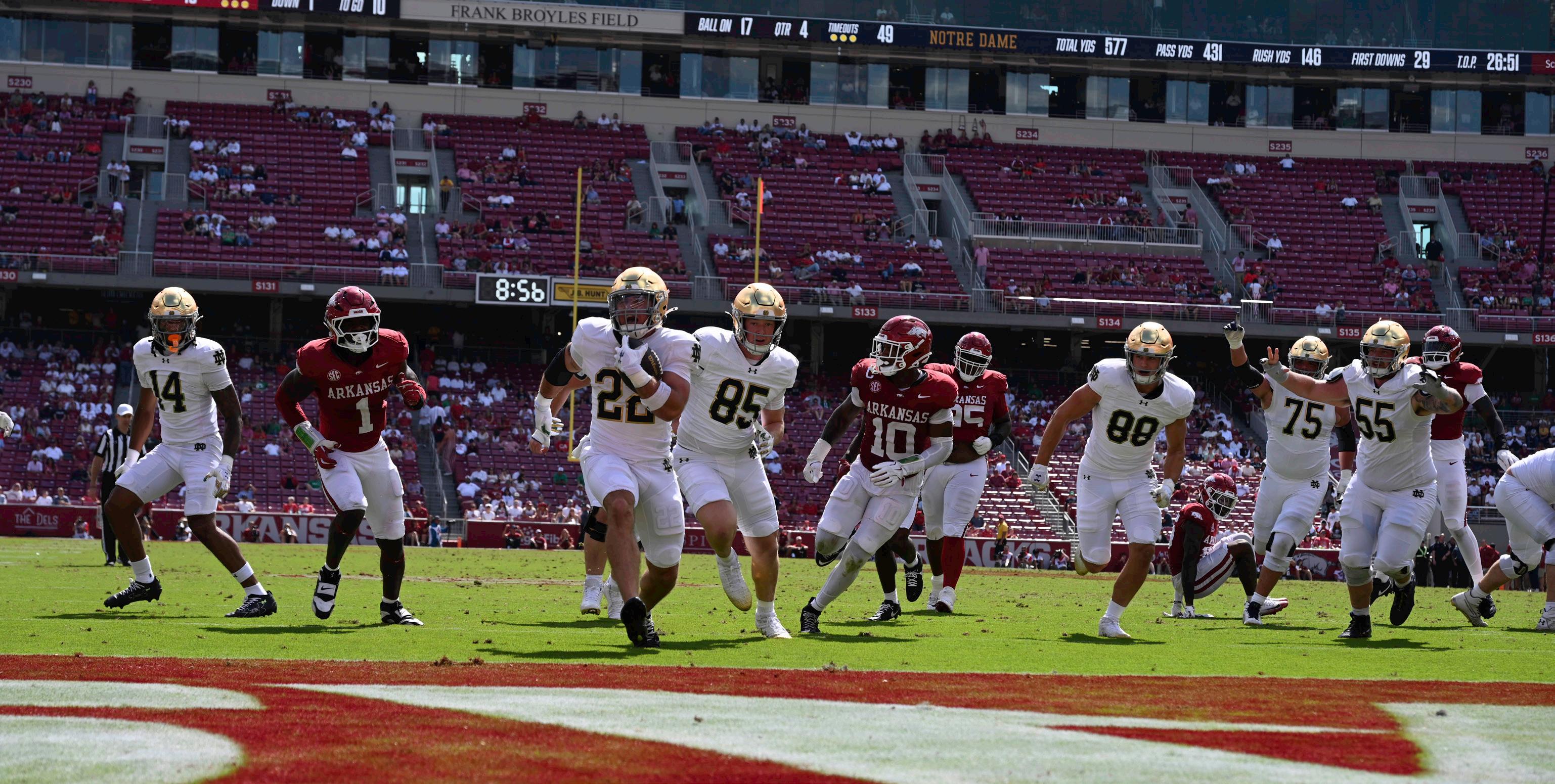
Football beat picks: Notre Dame vs. Boise State
By Observer Sports Staff Football Beat
Noah Cahill
Notre Dame put on a dominant display in Fayetteville, giving hope to Irish faithful that a College Football Playoff berth might still be possible. Boise State anticipated a step back after losing Heisman finalist Ashton Jeanty, but after a loss to South Florida in their season opener, the Broncos have rattled off three straight and look much closer to their 2024 selves. They bring a strong offense to South Bend that has put up 45-plus performances in all three wins.
Notre Dame’s defense passed the test against a high-powered Razorbacks offense that boasted numerous top-10 metrics. Despite surrendering a fair share of chunk plays, they stood strong in the red zone and turned Arkansas over twice. Freshman CJ Carr and the Irish offense, however, gave them plenty of margin for error. I foresee a similar script on Saturday, with the wealth of weapons being too much for the Broncos to handle. Notre Dame will get out on the front foot early at home and won’t look back.
Prediction: Notre Dame: 56, Boise State: 17
Chris Dailey
Just a season ago, Boise State was a College Football Playoff team. Led by the Heisman trophy runner-up Ashton Jeanty, much of the country rallied around the underdog Broncos before they were dismantled by Penn State. Unfortunately
for Boise State, last year is irrelevant. Notre Dame found that out the hard way against Miami and Texas A&M. The Broncos did against South Florida (USF).
Food for thought, USF beat Boise State 34-7. USF then lost to Miami 49-12. Notre Dame lost to Miami 27-24. Through transitive comparison, the Irish should beat the Broncos by 34 points. Now, I’m no mathematician, but that seems fair. Notre Dame’s offense is everything we thought it could be and more. The defense? Not amazing, but certainly improved upon from the first two weeks of action. Notre Dame knows it controls its destiny, and that’s a scary thought for their opponents. Jeremiyah Love and Jadarian Price will score two touchdowns apiece. The Irish will win this one convincingly.
Prediction: Notre Dame: 48, Boise State: 17
Ben Hicks
I’m now 1-3 in game picks on the year, and I wasn’t particularly close last week. It seems like Notre Dame’s defense has begun to figure things out, so hopefully I can follow their lead. Turning the page to Saturday, Boise State is a very talented Group of 5 program, but this isn’t the same Bronco bunch that made national noise a year ago. Since opening the year with an embarrassing performance at South Florida, the Bronco offense has averaged 49 points a game, albeit against Eastern Washington, Air Force and Appalachian State. Boise State’s defense is
flawed, however, which is not a recipe for success against the high-powered Irish attack. Bronco boss Spencer Danielson applauded Notre Dame’s CJ Carr as “a future first-round draft pick,” and Boise State simply doesn’t have the talent to slow down Carr, Jeremiah Love, Jadarian Price and the nation’s best offensive line. While the Irish defense will be tested once again, Notre Dame’s talent and motivation should lead them to a third consecutive blowout victory.
Prediction: Notre Dame: 52, Boise State: 24
Henry Lytle
I will give myself a little credit for having more faith than most in the Notre Dame defense to hold the Razorbacks well below their season average and win handily. Since I was backpacking abroad for the A&M and Purdue games, I’m now sitting at .500 on the season and hope to enter the positive just as Notre Dame does Saturday. While this Boise State team certainly does not possess the offensive firepower of Arkansas or dynamic dualthreat quarterback play, it still can be dangerous.
Without Heisman runnerup Ashton Jeanty, the Broncos have struggled to replicate the offensive statistics of last season and are relying heavily on throwing the ball downfield. While the Irish pass defense has struggled, I don’t see the skill on the outside similar to Miami or Texas A&M that gave the Irish problems before. This is a huge opportunity for defensive coordinator Chris Ash’s
defense to improve and find ways to effectively rush the passer.
On the other side of the ball, freshman CJ Carr is up to second in quarterback rating, and the running attack has been efficient at finding the endzone. Considering that stopping the run is the weakest part of Boise State’s defense, I think the Irish will have no problem starting the first half scorching hot, similar to a week ago in Fayetteville. I foresee a blowout and another step toward defensive improvement as the Irish set their sights toward NC State and, more importantly, USC in two weeks.
Prediction: Notre Dame: 49, Boise State: 10
Tyler Reidy
This is an interesting one for Notre Dame. You’ll have a pretty good “Irish Wear Green” environment on a bright, sunny day with a 2024 College Football Playoff quarterfinalist in town. And although we thought after Week One that Boise State had taken a massive step back, the Broncos have looked much closer to last year’s form during their active three-game win streak.
Traditionally, Marcus Freeman-led teams have struggled against Group of Five opponents, a category that Boise State falls under. Beyond the obvious losses to Marshall and Northern Illinois, the Irish won in slightly uncomfortable fashion against Central Michigan in 2023 and Miami (Ohio) last year. That said, Notre Dame still won those games by a combined 49 points, and I don’t
think it plays down to Boise State this weekend. With another big day from the running backs and a breakout showing from Jaden Greathouse, the Irish roll for a third consecutive week.
Prediction: Notre Dame: 41, Boise State: 17
Claire Watson
My predictions have not been anywhere close so far this season, other than Arkansas, but even then, I was quite a bit off on the score. The Irish put on a show last weekend as they trampled Arkansas. I see them doing the same with Boise State this weekend. Leading a seemingly unstoppable offense, freshman CJ Carr rounded out his performance in Fayetteville with 22 completed passes for a career high of 354 yards and four touchdowns. Carr also posted the first 294 passing yards in the first half of the game, the most from a Notre Damequarterback since 2008. While a talented team, the Broncos will have to watch out for Carr as they prepare for Saturday’s game. That’s not even mentioning Jeremiyah Love, who has re-entered the Heisman conversation with his last two games. The junior accounted for four touchdowns in the first half against Arkansas. Should Notre Dame keep utilizing their weapons, particularly the strong dynamic duo of their freshman quarterback and junior running back, I foresee the team being successful in the game against Boise State.
Prediction: Notre Dame: 56, Boise State: 14
GRAY NOCJAR | The Observer
Sophomore running back Aneyas Williams strides into the end zone untouched in Notre Dame’s dominant 56-13 win against Arkansas inside Razorback Stadium on Sept. 27, 2025. Williams got his fifth and sixth touches of the season late in the fourth quarter and took advantage, taking the pair of carries for 20 yards and a touchdown, extending the Irish lead.
FOOTBALL
